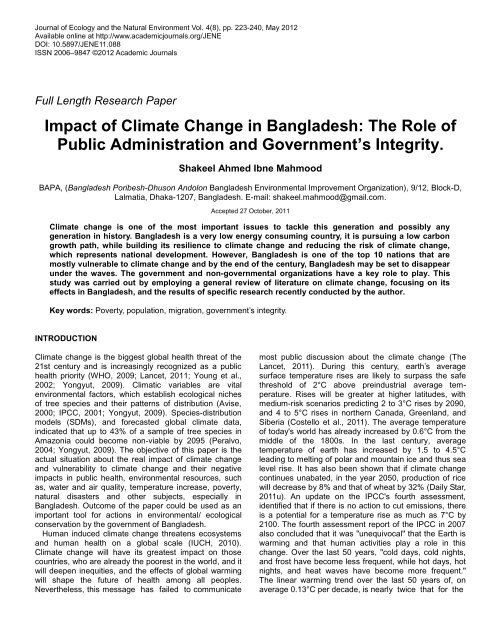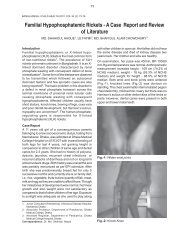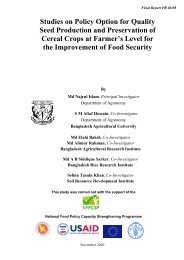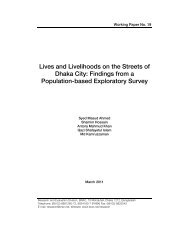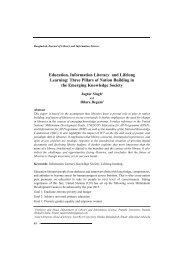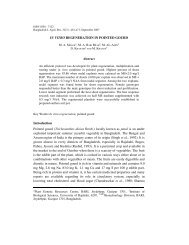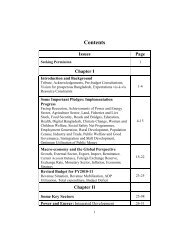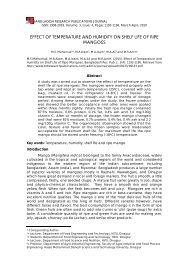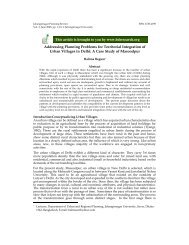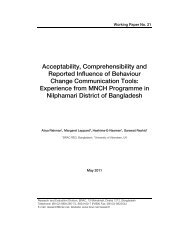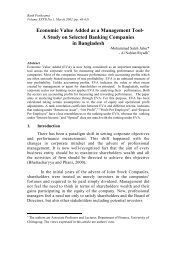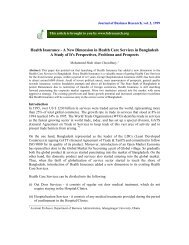Impact of Climate Change in Bangladesh: The Role of Public ...
Impact of Climate Change in Bangladesh: The Role of Public ...
Impact of Climate Change in Bangladesh: The Role of Public ...
Create successful ePaper yourself
Turn your PDF publications into a flip-book with our unique Google optimized e-Paper software.
Journal <strong>of</strong> Ecology and the Natural Environment Vol. 4(8), pp. 223-240, May 2012<br />
Available onl<strong>in</strong>e at http://www.academicjournals.org/JENE<br />
DOI: 10.5897/JENE11.088<br />
ISSN 2006–9847 ©2012 Academic Journals<br />
Full Length Research Paper<br />
<strong>Impact</strong> <strong>of</strong> <strong>Climate</strong> <strong>Change</strong> <strong>in</strong> <strong>Bangladesh</strong>: <strong>The</strong> <strong>Role</strong> <strong>of</strong><br />
<strong>Public</strong> Adm<strong>in</strong>istration and Government’s Integrity.<br />
Shakeel Ahmed Ibne Mahmood<br />
BAPA, (<strong>Bangladesh</strong> Poribesh-Dhuson Andolon <strong>Bangladesh</strong> Environmental Improvement Organization), 9/12, Block-D,<br />
Lalmatia, Dhaka-1207, <strong>Bangladesh</strong>. E-mail: shakeel.mahmood@gmail.com.<br />
Accepted 27 October, 2011<br />
<strong>Climate</strong> change is one <strong>of</strong> the most important issues to tackle this generation and possibly any<br />
generation <strong>in</strong> history. <strong>Bangladesh</strong> is a very low energy consum<strong>in</strong>g country, it is pursu<strong>in</strong>g a low carbon<br />
growth path, while build<strong>in</strong>g its resilience to climate change and reduc<strong>in</strong>g the risk <strong>of</strong> climate change,<br />
which represents national development. However, <strong>Bangladesh</strong> is one <strong>of</strong> the top 10 nations that are<br />
mostly vulnerable to climate change and by the end <strong>of</strong> the century, <strong>Bangladesh</strong> may be set to disappear<br />
under the waves. <strong>The</strong> government and non-governmental organizations have a key role to play. This<br />
study was carried out by employ<strong>in</strong>g a general review <strong>of</strong> literature on climate change, focus<strong>in</strong>g on its<br />
effects <strong>in</strong> <strong>Bangladesh</strong>, and the results <strong>of</strong> specific research recently conducted by the author.<br />
Key words: Poverty, population, migration, government‟s <strong>in</strong>tegrity.<br />
INTRODUCTION<br />
<strong>Climate</strong> change is the biggest global health threat <strong>of</strong> the<br />
21st century and is <strong>in</strong>creas<strong>in</strong>gly recognized as a public<br />
health priority (WHO, 2009; Lancet, 2011; Young et al.,<br />
2002; Yongyut, 2009). Climatic variables are vital<br />
environmental factors, which establish ecological niches<br />
<strong>of</strong> tree species and their patterns <strong>of</strong> distribution (Avise,<br />
2000; IPCC, 2001; Yongyut, 2009). Species-distribution<br />
models (SDMs), and forecasted global climate data,<br />
<strong>in</strong>dicated that up to 43% <strong>of</strong> a sample <strong>of</strong> tree species <strong>in</strong><br />
Amazonia could become non-viable by 2095 (Peralvo,<br />
2004; Yongyut, 2009). <strong>The</strong> objective <strong>of</strong> this paper is the<br />
actual situation about the real impact <strong>of</strong> climate change<br />
and vulnerability to climate change and their negative<br />
impacts <strong>in</strong> public health, environmental resources, such<br />
as, water and air quality, temperature <strong>in</strong>crease, poverty,<br />
natural disasters and other subjects, especially <strong>in</strong><br />
<strong>Bangladesh</strong>. Outcome <strong>of</strong> the paper could be used as an<br />
important tool for actions <strong>in</strong> environmental/ ecological<br />
conservation by the government <strong>of</strong> <strong>Bangladesh</strong>.<br />
Human <strong>in</strong>duced climate change threatens ecosystems<br />
and human health on a global scale (IUCH, 2010).<br />
<strong>Climate</strong> change will have its greatest impact on those<br />
countries, who are already the poorest <strong>in</strong> the world, and it<br />
will deepen <strong>in</strong>equities, and the effects <strong>of</strong> global warm<strong>in</strong>g<br />
will shape the future <strong>of</strong> health among all peoples.<br />
Nevertheless, this message has failed to communicate<br />
most public discussion about the climate change (<strong>The</strong><br />
Lancet, 2011). Dur<strong>in</strong>g this century, earth‟s average<br />
surface temperature rises are likely to surpass the safe<br />
threshold <strong>of</strong> 2°C above pre<strong>in</strong>dustrial average temperature.<br />
Rises will be greater at higher latitudes, with<br />
medium-risk scenarios predict<strong>in</strong>g 2 to 3°C rises by 2090,<br />
and 4 to 5°C rises <strong>in</strong> northern Canada, Greenland, and<br />
Siberia (Costello et al., 2011). <strong>The</strong> average temperature<br />
<strong>of</strong> today's world has already <strong>in</strong>creased by 0.6°C from the<br />
middle <strong>of</strong> the 1800s. In the last century, average<br />
temperature <strong>of</strong> earth has <strong>in</strong>creased by 1.5 to 4.5°C<br />
lead<strong>in</strong>g to melt<strong>in</strong>g <strong>of</strong> polar and mounta<strong>in</strong> ice and thus sea<br />
level rise. It has also been shown that if climate change<br />
cont<strong>in</strong>ues unabated, <strong>in</strong> the year 2050, production <strong>of</strong> rice<br />
will decrease by 8% and that <strong>of</strong> wheat by 32% (Daily Star,<br />
2011u). An update on the IPCC's fourth assessment,<br />
identified that if there is no action to cut emissions, there<br />
is a potential for a temperature rise as much as 7°C by<br />
2100. <strong>The</strong> fourth assessment report <strong>of</strong> the IPCC <strong>in</strong> 2007<br />
also concluded that it was "unequivocal" that the Earth is<br />
warm<strong>in</strong>g and that human activities play a role <strong>in</strong> this<br />
change. Over the last 50 years, "cold days, cold nights,<br />
and frost have become less frequent, while hot days, hot<br />
nights, and heat waves have become more frequent."<br />
<strong>The</strong> l<strong>in</strong>ear warm<strong>in</strong>g trend over the last 50 years <strong>of</strong>, on<br />
average 0.13°C per decade, is nearly twice that for the
224 J. Ecol. Nat. Environ.<br />
last 100 years. <strong>The</strong> total temperature <strong>in</strong>crease from the<br />
period 1850 to 1899 to the period 2001 to 2005 has been<br />
0.76°C (New Nation, 2011a). Hasna<strong>in</strong> (2000) and WWF<br />
(2005) mentioned <strong>in</strong> their studies that s<strong>in</strong>ce the mid<br />
1970s, the average air temperature measured at 49<br />
stations <strong>of</strong> the Himalayan region rose by 10°C with high<br />
elevation sites warm<strong>in</strong>g the most (New Nation, 2011b).<br />
A recent review, published <strong>in</strong> Nature Geoscience,<br />
suggests that with elevated atmospheric carbondioxide<br />
levels, it has been anticipated that additional green house<br />
gas emissions from soils, forests, and wetlands, lead<strong>in</strong>g<br />
to more warm<strong>in</strong>g (Global <strong>Change</strong>, 2011). Accord<strong>in</strong>g to the<br />
International Panel for <strong>Climate</strong> <strong>Change</strong> (2007), an<br />
<strong>in</strong>crease <strong>in</strong> the average global temperature will lead to<br />
changes <strong>in</strong> precipitation, and atmospheric moisture due<br />
to the changes <strong>in</strong> atmospheric circulation, and <strong>in</strong>creases<br />
<strong>in</strong> evaporation, and water vapor. It was further supported<br />
by two new studies published <strong>in</strong> the British journal Nature<br />
(New Age, 2011a). <strong>The</strong> ecological <strong>in</strong>teraction <strong>of</strong> cities and<br />
their h<strong>in</strong>terlands is recurr<strong>in</strong>g theme. Rapid urbanization<br />
and climate change have given it a new impetus and<br />
sense <strong>of</strong> urgency. Expected population growth and<br />
migration mean that urban expansion will be the most<br />
common and universal development challenge. However,<br />
urban expansion can take the form <strong>of</strong> urban sprawl; it is<br />
then costly, wasteful, and ecologically destructive (Anna,<br />
2011). By 2050, the urban population <strong>of</strong> the develop<strong>in</strong>g<br />
world will be 5.3 billion; Asia alone will host 63% <strong>of</strong> the<br />
world‟s urban population, or 3.3 billion people. <strong>The</strong> UN<br />
predicts that there will be millions <strong>of</strong> environmental<br />
migrants by 2020, and climate change is one <strong>of</strong> the major<br />
drivers (Anna, 2011). Regardless <strong>of</strong> the specific causes<br />
and drivers, there is clear evidence that our climate is<br />
chang<strong>in</strong>g and that the pace and scale <strong>of</strong> that change is<br />
accelerat<strong>in</strong>g <strong>in</strong> many areas. <strong>The</strong> IPCC's fifth assessment<br />
will be released <strong>in</strong> 2013/2014, but already many teams <strong>of</strong><br />
scientists claim the forecasts and scenarios <strong>of</strong> future<br />
climate change <strong>in</strong> the fourth IPCC assessment are be<strong>in</strong>g<br />
overtaken. A recent conclusions from the Snow, Water,<br />
Ice and Permafrost <strong>in</strong> the Arctic report <strong>of</strong> the Arctic<br />
Monitor<strong>in</strong>g and Assessment Programme (AMAP), mentioned<br />
that there is likely global sea-level rise <strong>of</strong> close to 1<br />
m or more by the end <strong>of</strong> the century as a result <strong>of</strong>, for<br />
<strong>in</strong>stance, faster melt<strong>in</strong>g <strong>of</strong> the Greenland ice sheets. This<br />
compares with the 0.18 and 0.59 m forecast by the IPCC<br />
four years ago (New Nation, 2011a).<br />
<strong>Climate</strong> change is tak<strong>in</strong>g a toll on not only the ecology<br />
<strong>of</strong> nations around the world, but also their political,<br />
economic and social stability, with the poorest nations<br />
and the poorest <strong>of</strong> the rich nations be<strong>in</strong>g the worst<br />
sufferers ( Daily Star, 2011b). A one-meter rise <strong>in</strong> sea<br />
level could, for <strong>in</strong>stance, flood 17% <strong>of</strong> <strong>Bangladesh</strong>'s land<br />
area; threaten large parts <strong>of</strong> coastal cities such as Lagos,<br />
Cape Town and elsewhere and overwhelm, along with<br />
storm surges, small Island develop<strong>in</strong>g States from the<br />
Maldives to Tuvalu. A World Bank study has estimated<br />
that a one-meter sea-level rise would affect 84<br />
develop<strong>in</strong>g countries alone. Recent studies have found<br />
that up to 12% <strong>of</strong> the world GDP is already at risk from<br />
exist<strong>in</strong>g climate patterns. For example, the value <strong>of</strong> GDP<br />
exposed to tropical cyclones alone more than tripled from<br />
US$525.7 billion <strong>in</strong> the 1970s to US$1.6 trillion <strong>in</strong> the first<br />
decade <strong>of</strong> the 2000s (New Nation, 2011). <strong>The</strong> Global<br />
Susta<strong>in</strong>ability Panel, recently set up by UN Secretary<br />
General Ban Ki-moon, is an attempt to br<strong>in</strong>g a holistic<br />
approach to bear on issues, such as climate change,<br />
food, and water security, and development. However, it is<br />
has been felt that sufficient experience is lack<strong>in</strong>g with<br />
how to connect dots, how to br<strong>in</strong>g together concepts like<br />
climate change, and poverty eradication, climate change,<br />
and food security, and climate change, and access to<br />
water. Ultimately, if climate change is not be<strong>in</strong>g solved,<br />
then poverty eradication, food security, access to water<br />
cannot be solved either (Global <strong>Change</strong>, 2011).<br />
Secretary-General <strong>of</strong> UN, Ban Ki-moon affirmed that<br />
climate change was an "unholy brew" that could create<br />
perilous security vacuums, and that we must address a<br />
clear danger that not only exacerbated the threats but<br />
was itself a threat to <strong>in</strong>ternational peace and security<br />
(Daily Star, 2011k).<br />
<strong>The</strong> problem<br />
Firstly, there is a massive gap <strong>in</strong> <strong>in</strong>formation, an<br />
astonish<strong>in</strong>g lack <strong>of</strong> knowledge about how we should<br />
respond to the negative health effects <strong>of</strong> climate change.<br />
Secondly, s<strong>in</strong>ce the effects <strong>of</strong> climate change will hit the<br />
poor hardest, an immense task before us to address the<br />
<strong>in</strong>adequacies <strong>of</strong> health systems to protect people <strong>in</strong><br />
countries most at risk. Thirdly, technologies do have the<br />
potential to help us adapt to changes <strong>in</strong> climate. But<br />
these technologies have to be developed out <strong>of</strong> greater<br />
research <strong>in</strong>vestments <strong>in</strong>to climate change science, better<br />
understand<strong>in</strong>g about how to deliver those technologies <strong>in</strong><br />
the field and more complete appreciation <strong>of</strong> the social<br />
and cultural dimension <strong>in</strong>to, which those technologies<br />
might be implanted. Fourthly challenge is political<br />
creat<strong>in</strong>g the conditions for low carbon liv<strong>in</strong>g. And f<strong>in</strong>ally<br />
there is the question <strong>of</strong> how we adapt our <strong>in</strong>tuitions to<br />
make climate change the priority it needs to be (<strong>The</strong><br />
Lancet, 2011).<br />
Identify<strong>in</strong>g urgent and immediate research needs for<br />
evidence based action is another important step <strong>in</strong><br />
reduc<strong>in</strong>g the health risks <strong>of</strong> climate change. Fill<strong>in</strong>g these<br />
research gaps requires a susta<strong>in</strong>ed process to mobilize<br />
resources and update objectives as need change<br />
(Lancet, 2008) and crucially important is to build<br />
<strong>in</strong>terdiscipl<strong>in</strong>ary research capacity, with a focus on the<br />
low <strong>in</strong>come countries that are the most vulnerable to the<br />
health effects <strong>of</strong> climate change and have the weak<br />
research base (Diarmid et al., 2011). But the challenges<br />
are complex and daunt<strong>in</strong>g, and require cont<strong>in</strong>uous<br />
engagement and effort at all levels. A security <strong>of</strong>
Mahmood 225<br />
<strong>in</strong>terrelated phenomena unfold<strong>in</strong>g <strong>in</strong> our times is<br />
mak<strong>in</strong>g the issues <strong>of</strong> human ecology and urbanization a<br />
matter <strong>of</strong> urgency (Anna, 2011).<br />
Natural disasters around the world<br />
Accord<strong>in</strong>g to the United Nations High Commissioner for<br />
Refugees (UNHCR) <strong>in</strong> 2010 about 42 million people<br />
around the world were forced to flee their homes because<br />
<strong>of</strong> natural disasters. What is alarm<strong>in</strong>g is that the number<br />
<strong>of</strong> <strong>in</strong>ternally displaced people because <strong>of</strong> natural<br />
disasters almost doubled between 2009 and 2010. <strong>The</strong><br />
UNHCR report also po<strong>in</strong>ted out that climate change is the<br />
most important factor contribut<strong>in</strong>g to natural disasters,<br />
and that the <strong>in</strong>ternational community must recognize this<br />
fact, and do more to help the suffer<strong>in</strong>g humanity. <strong>The</strong><br />
number <strong>of</strong> <strong>in</strong>ternally displaced people <strong>in</strong> 2010 was 42<br />
million is equal to the entire population <strong>of</strong> Argent<strong>in</strong>a and<br />
almost 50% more than the total population <strong>of</strong> Canada.<br />
<strong>The</strong> Internal Displacement Monitor<strong>in</strong>g Centre <strong>of</strong> the<br />
UNHCR noted that „mega disasters‟ like the floods <strong>in</strong><br />
Ch<strong>in</strong>a and Pakistan, and the earthquake <strong>in</strong> Chile, and<br />
Haiti were responsible for the massive <strong>in</strong>crease <strong>in</strong> the<br />
<strong>in</strong>ternally displaced people from 17 million <strong>in</strong> 2009 to<br />
about 42 million <strong>in</strong> 2010. It also noted that weather<br />
related hazards like floods, and storms were responsible<br />
for more than 90% <strong>of</strong> the disaster displacements (New<br />
Age, 2011b).<br />
Among the IPCC's other f<strong>in</strong>d<strong>in</strong>gs <strong>in</strong> 2007 was that<br />
storms and cyclones have become more <strong>in</strong>tense over the<br />
past 30 years and that droughts, especially <strong>in</strong> the tropics<br />
and sub-tropics, have become more frequent with<br />
implications for food security. <strong>The</strong>rmal expansion <strong>of</strong> the<br />
oceans is contribut<strong>in</strong>g to sea-level rise <strong>of</strong> on average 1.8<br />
mm a year s<strong>in</strong>ce the 1960s. S<strong>in</strong>ce 1978 satellites show<br />
that the extent <strong>of</strong> summer Arctic sea ice has fallen by<br />
20% (New Nation, 2011a). A developed country like USA,<br />
also realized the effect <strong>of</strong> climate change. Brian Holland,<br />
director <strong>of</strong> climate programs at ICLEI-Local Governments<br />
for Susta<strong>in</strong>ability, USA says that It is a new field. His<br />
organization recently launched a <strong>Climate</strong> Resilient<br />
Communities program to help cities study effects <strong>of</strong><br />
climate change and f<strong>in</strong>ance ways to adapt (USA Today,<br />
2011). Almost 600 local governments, which is one-fourth<br />
<strong>of</strong> the U.S. population, have signed on. Due to extreme<br />
weather cont<strong>in</strong>ues to sweep the nation, and Americans<br />
struggle to deal with heat waves and flood<strong>in</strong>g, Holland<br />
mentioned that majority people are conv<strong>in</strong>ced that they<br />
need to act. "We're already see<strong>in</strong>g consequences <strong>of</strong><br />
climate change," he says, "and those will only <strong>in</strong>tensify"<br />
(USA Today, 2011).<br />
METHODOLOGY<br />
Information was retrieved from documents available ma<strong>in</strong>ly <strong>in</strong><br />
electronic database, and on the websites <strong>of</strong> specialized agencies,<br />
us<strong>in</strong>g the terms „<strong>Climate</strong> <strong>Change</strong>‟, and „<strong>Bangladesh</strong>‟ with other<br />
researchers work was undertaken, <strong>in</strong>clud<strong>in</strong>g 4 lead<strong>in</strong>g <strong>Bangladesh</strong><br />
daily newspapers also analyzed. 85 documents were retrieved from<br />
the database (websites) <strong>of</strong> several national, and <strong>in</strong>ternational<br />
agencies were browsed. <strong>The</strong> most important be<strong>in</strong>g onl<strong>in</strong>e collection<br />
from different journals on climate change related issues. <strong>The</strong>se<br />
sites housed a number <strong>of</strong> reports on quantitative and qualitative<br />
studies, estimates <strong>of</strong> climate change cases, policy analysis <strong>of</strong> the<br />
exist<strong>in</strong>g climate change situation and reduc<strong>in</strong>g the vulnerability due<br />
to climate change <strong>in</strong> <strong>Bangladesh</strong> and government strategies. This<br />
paper also looked deeper at the sectoral issues and policy.<br />
<strong>The</strong> paper tried to contribute to the exist<strong>in</strong>g literature, <strong>in</strong> the form<br />
<strong>of</strong> new f<strong>in</strong>d<strong>in</strong>gs and <strong>in</strong> the form <strong>of</strong> critical <strong>in</strong>terpretation <strong>of</strong> exist<strong>in</strong>g<br />
ones. Histological observations were carried out and a crosssectional<br />
prevalence study <strong>of</strong> climate change and <strong>Bangladesh</strong> was<br />
also held. A scrut<strong>in</strong>y <strong>of</strong> the abstract revealed that some<br />
presentation posted on the websites, which was presented <strong>in</strong><br />
<strong>in</strong>ternational conferences and few other presentations were<br />
published <strong>in</strong> journals. Collected documents were skim read to<br />
cases, whether they conta<strong>in</strong>ed <strong>in</strong>formation on <strong>Bangladesh</strong> <strong>in</strong><br />
conjunction with climate change.<br />
Def<strong>in</strong>ition <strong>of</strong> climate change<br />
<strong>Climate</strong> change is identified as an average weather condition <strong>of</strong> an<br />
area characterized by its own <strong>in</strong>ternal dynamics and by chang<strong>in</strong>g <strong>in</strong><br />
external factors that affect climate (Trewartha et al., 1980). United<br />
Nations Framework Convention on <strong>Climate</strong> <strong>Change</strong> (UNFCC)<br />
def<strong>in</strong>es climate change as the change result<strong>in</strong>g from long term<br />
direct and <strong>in</strong>direct activities that <strong>in</strong>duces changes <strong>in</strong> the compared<br />
time which are much more than the natural change (Daily Star,<br />
2011u). On the other hand, the weather is a set <strong>of</strong> all the<br />
phenomena occurr<strong>in</strong>g <strong>in</strong> a given atmosphere at a given time (IAC,<br />
2011).<br />
BANGLADESH<br />
Geographically, <strong>Bangladesh</strong> is located <strong>in</strong> the tropical region (FAO,<br />
2011). Natural disaster is a common phenomenon and till today<br />
<strong>Bangladesh</strong> is fac<strong>in</strong>g several disasters, and climate change is the<br />
ma<strong>in</strong> reason beh<strong>in</strong>d it (Daily Star, 2011a). <strong>Bangladesh</strong> lies on a<br />
deltaic pla<strong>in</strong> with five major river systems: the Jamuna-<br />
Brahmaputra, the Padma-Ganges, the Surma-Meghna, the Padma-<br />
Meghna, and the Karnaphuli. Although altitudes up to 105 m above<br />
sea level occur <strong>in</strong> the northern part <strong>of</strong> the pla<strong>in</strong>, most elevations are<br />
less than 10 m above sea level; elevations decrease <strong>in</strong> the coastal<br />
south, where the terra<strong>in</strong> is generally at sea level. <strong>The</strong>se<br />
geographical features make <strong>Bangladesh</strong> vulnerable to natural<br />
disasters, such as floods and cyclones, and the high levels <strong>of</strong><br />
poverty <strong>in</strong>crease the enormity <strong>of</strong> the challenges that the country is<br />
likely to face from climate change (ICDDR B, 2011a) (Figure 1).<br />
<strong>Bangladesh</strong> is one <strong>of</strong> the most densely populated nations on<br />
Earth. It has more people than geographically massive Russia<br />
(Envo<strong>in</strong>fo, 2011). <strong>Bangladesh</strong> ranked fifth most vulnerable country<br />
to climate change and hunger <strong>in</strong> an Action Aid research report. In<br />
the World Risk Index 2011, jo<strong>in</strong>tly conducted by United Nations<br />
University (UNU), Germany and the Institute <strong>of</strong> Environment and<br />
Human Security said that <strong>Bangladesh</strong> ranked sixth among<br />
countries that are most vulnerable to natural disasters, while<br />
second among the Asian countries ( Daily Star, 2011z).<strong>Bangladesh</strong><br />
is a very low energy consum<strong>in</strong>g country, and it is pursu<strong>in</strong>g a low<br />
carbon growth path, while build<strong>in</strong>g its resilience to climate change<br />
and reduc<strong>in</strong>g the risk <strong>of</strong> climate change, which shows national<br />
development (Daily Star, 2009a). <strong>Bangladesh</strong> is projected to be 0.5<br />
to 0.2°C warmer than today by the year 2030. <strong>The</strong> 30 years mean<br />
summer temperature <strong>in</strong> <strong>Bangladesh</strong> is 27.5°C and the mean
226 J. Ecol. Nat. Environ.<br />
Figure 1. Areas <strong>in</strong> <strong>Bangladesh</strong> and their vulnerability to flood<strong>in</strong>g. Source:<br />
http://www.banglapedia.org/httpdocs/Maps/MF_0103A.GIF<br />
summer temperature is relatively higher dur<strong>in</strong>g the monsoon than<br />
dur<strong>in</strong>g summer. W<strong>in</strong>ter is the driest season <strong>in</strong> <strong>Bangladesh</strong>. <strong>The</strong> 30<br />
years mean w<strong>in</strong>ter ra<strong>in</strong>fall amounts to about 64 mm with a variability<br />
<strong>of</strong> around 53%. By 2030, the best estimate projection is for<br />
monsoon ra<strong>in</strong>fall to <strong>in</strong>crease by 10 to 15% and w<strong>in</strong>ter ra<strong>in</strong>fall by 5 to<br />
10% (Kafiludd<strong>in</strong>, 2005).<br />
Population<br />
<strong>The</strong> country's population now stands at 16 crore (Daily Star, 2011j),<br />
which is 1.8 crore more than a decade ago- leave beh<strong>in</strong>d almost<br />
unimag<strong>in</strong>able ecological footpr<strong>in</strong>ts. <strong>Bangladesh</strong> is the third most<br />
populated country <strong>in</strong> South-East Asia after India and Pakistan,
Mahmood 227<br />
Figure 2. <strong>Climate</strong> threat and the impact from calamity, Monpura, Bhola.<br />
which have 121.45 crore and 18.48 crore people, accord<strong>in</strong>g to<br />
United Nations Population Fund. Its population now is higher than<br />
the comb<strong>in</strong>ed total <strong>of</strong> Thailand, Myanmar, Sri Lanka and<br />
S<strong>in</strong>gapore.<strong>The</strong> number <strong>of</strong> people liv<strong>in</strong>g <strong>in</strong> every square kilometer is<br />
964, compared to 834 <strong>in</strong> 2001. Currently, household size is 4.4<br />
persons, compared to 4.8 <strong>in</strong> 2001 and 5.5 <strong>in</strong> 1991. <strong>The</strong> number <strong>of</strong><br />
people liv<strong>in</strong>g <strong>in</strong> every square kilometer is 964, compared to 834 <strong>in</strong><br />
2001 (Daily Star, 2011f). In the year 2050, when population <strong>of</strong><br />
<strong>Bangladesh</strong> will likely have zoomed to 220 million and then to<br />
decl<strong>in</strong>e. This is the first time that a formal report has predicted a<br />
decl<strong>in</strong>e that will start at mid-century‟ (ICDDR,B, 2011), and a good<br />
chunk <strong>of</strong> its current landmass could be permanently underwater.<br />
That scenario is based on two converg<strong>in</strong>g projections: population<br />
growth and a possible multifoot rise <strong>in</strong> sea level by 2100 as a result<br />
<strong>of</strong> climate change. Such a scenario could mean that 35 million<br />
people along the southern coast would be displaced as IPPC<br />
warned (Planetizen, 2008,) and will face „safe water crisis‟ (<strong>Climate</strong><br />
adapt, 2011) and „religious conflict‟ (Envo<strong>in</strong>fo, 2010), forc<strong>in</strong>g<br />
<strong>Bangladesh</strong>is to crowd even closer together or else flee the country<br />
as climate refugees, a group predicted to swell to some 250 million<br />
worldwide by the middle <strong>of</strong> the century, many from poor, low-ly<strong>in</strong>g<br />
countries. A recent study <strong>of</strong> 136 port cities found that those with the<br />
largest threatened populations will be <strong>in</strong> develop<strong>in</strong>g countries,<br />
especially those <strong>in</strong> Asia. Worldwide, the two cities that will have the<br />
greatest proportional <strong>in</strong>crease <strong>in</strong> people exposed to climate<br />
extremes by 2070 are both <strong>in</strong> <strong>Bangladesh</strong>: Dhaka and Chittagong,<br />
with Khulna close beh<strong>in</strong>d (Envo<strong>in</strong>fo, 2010).<br />
Dhaka is the capital <strong>of</strong> <strong>Bangladesh</strong> and is overcrowded, even<br />
every park and footpath has been occupied by the homeless.<br />
Thousands <strong>of</strong> people arrive <strong>in</strong> Dhaka each day, flee<strong>in</strong>g river<br />
flood<strong>in</strong>g <strong>in</strong> the north and cyclones <strong>in</strong> the south. Many <strong>of</strong> them end<br />
up liv<strong>in</strong>g <strong>in</strong> the slums <strong>of</strong> Dhaka, where hundreds <strong>of</strong> thousands <strong>of</strong><br />
such migrants already colonized. Dhaka is <strong>in</strong> no shape to take <strong>in</strong><br />
new <strong>in</strong>habitants. It is already under pressure to provide the most<br />
basic services and <strong>in</strong>frastructure. (Envo<strong>in</strong>fo, 2010). <strong>The</strong> population<br />
<strong>of</strong> Dhaka is grow<strong>in</strong>g at a rate <strong>of</strong> 4.4% per year, one <strong>of</strong> the highest <strong>in</strong><br />
the world. Around 500,000 people, almost the population <strong>of</strong><br />
Wash<strong>in</strong>gton DC, move to Dhaka and the banks <strong>of</strong> the river<br />
Buriganga annually. Almost 90% <strong>of</strong> the rural migrant population is<br />
absorbed <strong>in</strong> the four major cities -- Dhaka, Chittagong, Khulna and<br />
Rajshahi (Daily Star, 2011r). In the slums tens <strong>of</strong> thousands <strong>of</strong><br />
people take shelter <strong>in</strong> huts made <strong>of</strong> cardboard with polythene ro<strong>of</strong>s.<br />
<strong>The</strong>re is no runn<strong>in</strong>g water or sanitation. With 13 million residents,<br />
up from 3,440,000 only 30 years ago, Dhaka is considered the most<br />
populous urban centre on earth (Daily Star, 2011e). Displacement<br />
from natural disasters such as Aila resulted <strong>in</strong>to large exodus <strong>of</strong><br />
rural people to urban people. This migration results <strong>in</strong>to an<br />
unbearable pressure on urban utilities such as water and sanitation<br />
services. <strong>Climate</strong> change is believed to affect <strong>Bangladesh</strong> river<br />
system badly as the melt<strong>in</strong>g <strong>of</strong> Himalayan glaciers will result <strong>in</strong><br />
higher flow <strong>of</strong> water <strong>in</strong> the river, which <strong>in</strong> turn will result <strong>in</strong>to flood<br />
and water logg<strong>in</strong>g <strong>in</strong> huge urban areas. <strong>The</strong> water supply <strong>of</strong> Dhaka<br />
city will face a great crisis as its source <strong>of</strong> water will not rema<strong>in</strong><br />
susta<strong>in</strong>able and people will not be able to get sufficient safe<br />
dr<strong>in</strong>k<strong>in</strong>g water (Daily Star, 2011c).<br />
Cop<strong>in</strong>g with climate change<br />
More than 259 extreme natural events hit <strong>Bangladesh</strong> dur<strong>in</strong>g the<br />
period 1991 to 2009. More than 80% <strong>of</strong> the deaths occurred <strong>in</strong> 1991<br />
<strong>in</strong> <strong>Bangladesh</strong>. In 1991, a total <strong>of</strong> 140,000 people died <strong>in</strong><br />
<strong>Bangladesh</strong> and the number significantly fall <strong>in</strong> next year‟s, which<br />
can be seen as partial evidence, which is possible to better prepare<br />
for climate threat and prevent larger scale impacts from catastrophe<br />
(Daily Star, 2010a).<br />
S<strong>in</strong>ce 1970, accord<strong>in</strong>g to a statistics, about 39 million people have<br />
been displaced by major natural calamities like flood and cyclone <strong>in</strong><br />
the country till 2009. Experts warn that about 6-8 million more<br />
people <strong>of</strong> <strong>Bangladesh</strong> could be displaced due to <strong>in</strong>crease <strong>in</strong> global
228 J. Ecol. Nat. Environ.<br />
Figure 3. River erosion, Lalmohon Vola.<br />
temperature and sea-level rise by 2050 (Daily Star, 2011)<br />
(Figure 2).<br />
RESULTS<br />
<strong>Bangladesh</strong> is set to disappear under the waves<br />
<strong>Bangladesh</strong> is one <strong>of</strong> the top 10 nations mostly<br />
vulnerable to climate change, said German watch Global<br />
<strong>Climate</strong> Risk Index (CRI)-2011 report. By the end <strong>of</strong> the<br />
century, <strong>Bangladesh</strong> is set to disappear under the waves<br />
as mentioned by US government's NASA space agency.<br />
<strong>The</strong> International Panel on <strong>Climate</strong> <strong>Change</strong> (IPCC)<br />
predicted that by 2050, <strong>Bangladesh</strong> is on course to lose<br />
17% <strong>of</strong> its land and 30% <strong>of</strong> its food production and as a<br />
result poverty will <strong>in</strong>crease (Planetizen, 2008; <strong>The</strong><br />
Independent, 2008). <strong>The</strong> country has already begun to<br />
feel the effects <strong>of</strong> the climate change as flood periods<br />
have become longer and the cyclones, droughts and<br />
earth quakes that hit the country cause greater<br />
devastation and adversely affect<strong>in</strong>g the country's<br />
agriculture and land, and challeng<strong>in</strong>g water resources,<br />
occupational dislocations, food, health, energy and urban<br />
plann<strong>in</strong>g (Chimalaya, 2011) (Figure 3).<br />
<strong>The</strong> Healthy Center for <strong>Climate</strong> Prediction and<br />
Research (HCCPR) estimates that sea level <strong>in</strong><br />
<strong>Bangladesh</strong> will rise about 40 cm (15 <strong>in</strong>ches) by 2080<br />
(Streatfield, 2008).Water level rises by at least 5.6 mm a<br />
year at Hiron po<strong>in</strong>t, 1.4 mm at Cox's Bazar and 2.9 mm at<br />
Khepupara, which was citied 2008 data from <strong>Bangladesh</strong><br />
Water Development Board (ANN, 2010a). <strong>The</strong> climate<br />
models suggest that temperature will <strong>in</strong>crease <strong>in</strong><br />
<strong>Bangladesh</strong> dur<strong>in</strong>g all seasons by approximately 1.0 to<br />
15°C by 2030 (Kafiludd<strong>in</strong>, 2005). <strong>The</strong> Prime M<strong>in</strong>ister <strong>of</strong><br />
<strong>Bangladesh</strong> referred to the more extreme estimations<br />
that a one-metre rise <strong>in</strong> the sea level would submerge a<br />
quarter <strong>of</strong> <strong>Bangladesh</strong>‟s land mass (News Today, 2011).<br />
Disappearance <strong>of</strong> Sundarban, the Bengal tiger and<br />
birds<br />
It was mentioned that the mangrove forests <strong>of</strong> the<br />
Sundarbans, the Bengal tiger and hundreds <strong>of</strong> bird<br />
species may disappear (Daily Star, 2011). <strong>Bangladesh</strong>
Mahmood 229<br />
Figure 4. Proximity <strong>of</strong> animals and humans. Shahapara- near Tista barrage, Chapa<strong>in</strong>obabgonj.<br />
and India shares important and sensitive ecological<br />
treasures, such as the mangrove forests <strong>of</strong> Sundarban<br />
and hill forests on <strong>Bangladesh</strong>‟s north and eastern<br />
border. <strong>The</strong>se forests are rich <strong>in</strong> bio-diversity and they<br />
are also the areas, where members <strong>of</strong> many ethnic<br />
m<strong>in</strong>orities live. It is the jo<strong>in</strong>t responsibility <strong>of</strong> India and<br />
<strong>Bangladesh</strong> to preserve and cherish these ecological<br />
treasures and to protect the rights <strong>of</strong> the ethnic m<strong>in</strong>orities,<br />
who have been traditionally liv<strong>in</strong>g there (New Age,<br />
2011c).<br />
Ris<strong>in</strong>g sal<strong>in</strong>ity threatens Sundarban<br />
Decreas<strong>in</strong>g flow <strong>of</strong> water through the rivers from<br />
upstream is destroy<strong>in</strong>g the ecosystem <strong>of</strong> Sundarban.<br />
Experts from home and abroad observed that alarm<strong>in</strong>g<br />
decrease <strong>in</strong> water flow down the rivers caused high<br />
sal<strong>in</strong>ity <strong>in</strong> both water and soil <strong>of</strong> Sundarban, caus<strong>in</strong>g a<br />
massive change <strong>in</strong> faunal composition <strong>of</strong> the forest.<br />
Sundarban, which lies across the outer deltas <strong>of</strong> the<br />
Ganges, Brahmaputra and Meghna rivers, is the largest<br />
mangrove forest <strong>in</strong> the world. <strong>The</strong> number <strong>of</strong> timber<br />
produc<strong>in</strong>g big trees such as Sundari is decreas<strong>in</strong>g at the<br />
proportionate rate at the <strong>in</strong>crease <strong>of</strong> sal<strong>in</strong>ity,‟ Abstract<br />
from a paper on „Biodiversity and its Conservation <strong>in</strong><br />
Sundarban Mangrove Ecosystem‟ by Indian scholars Brij<br />
Science journal also revealed the same result (New Age<br />
, 2011d). <strong>The</strong> latest report <strong>of</strong> World Conservation<br />
Monitor<strong>in</strong>g warned that a long-term ecological change is<br />
tak<strong>in</strong>g place <strong>in</strong> Sundarban due to the eastward migration<br />
<strong>of</strong> the Ganges, abandonment <strong>of</strong> some distributaries and<br />
past diversion <strong>of</strong> water and withdrawals for irrigation<br />
(New Age, 2011d) (Figure 4).<br />
People are vulnerable to diseases<br />
ICDDR,B- an International Centre for health and<br />
population forecasted that climate change would also<br />
make people <strong>in</strong> <strong>Bangladesh</strong> vulnerable to <strong>in</strong>creased<br />
prevalence <strong>of</strong> diseases, such as cholera, dengue,<br />
cardiovascular, respiratory diseases, and malnutrition<br />
due to food scarcity and reduction <strong>in</strong> food production<br />
(ICDDR,B, 2011). In 2030, the estimated risk <strong>of</strong> diarrhoea<br />
will be up to 10% higher <strong>in</strong> some regions than if no<br />
climate change occured (Kafiludd<strong>in</strong>, 2005). <strong>Climate</strong><br />
change will also lead to poorer nutrition, putt<strong>in</strong>g people<br />
with perilous immune systems at more risk <strong>of</strong> dy<strong>in</strong>g <strong>of</strong><br />
HIV, „as well as contract<strong>in</strong>g and transmitt<strong>in</strong>g new and<br />
unusual <strong>in</strong>fections as mentioned by Prom<strong>in</strong>ent Australian<br />
HIV scientist <strong>of</strong> National Centre <strong>in</strong> HIV Epidemiology and<br />
Cl<strong>in</strong>ical Research, NCHECR (Daily Star, 2010b).<br />
ICDDR,B also mentioned that the threat <strong>of</strong> prolonged<br />
flood<strong>in</strong>g will also decrease the space available for the<br />
Gopal and Malavika Chauhan published <strong>in</strong> the Aquatic
230 J. Ecol. Nat. Environ.<br />
Figure 5. <strong>Change</strong>s <strong>of</strong> sea level rise, ShunamGonj, Sylhet.<br />
construction <strong>of</strong> residential build<strong>in</strong>gs and the cultivation <strong>of</strong><br />
crops and farm<strong>in</strong>g <strong>of</strong> animals, which eventually lead<br />
humans and animals <strong>in</strong> migration to urban areas, and<br />
beyond, which will „br<strong>in</strong>g further pressure on our denselypopulated<br />
country (a grow<strong>in</strong>g number <strong>of</strong> people will be<br />
liv<strong>in</strong>g <strong>in</strong> slums ) and accelerate urbanization, which, <strong>in</strong><br />
turn, will result <strong>in</strong> strong competition between urban<br />
people for access to social and economic opportunities<br />
(ICDDR,B 2011a; New Age, 2011) and, <strong>in</strong>crease crime,<br />
which will lead to a social <strong>in</strong>stability (Daily Star, 2011b).<br />
Between 35 and 77 million <strong>of</strong> the 165 million<br />
<strong>Bangladesh</strong>is, are at risk <strong>of</strong> dr<strong>in</strong>k<strong>in</strong>g contam<strong>in</strong>ated water.<br />
Accord<strong>in</strong>g to the British medical journal “<strong>The</strong> Lancet,” up<br />
to 77 million people have been exposed to arsenic that<br />
can cause 200,000 to 270,000 deaths from cancer alone<br />
<strong>in</strong> <strong>Bangladesh</strong> (Daily Star, 2011k). Another source<br />
revealed <strong>in</strong> their research that climate change can upset<br />
the ecological balance between parasites, <strong>in</strong>termidiate<br />
hosts, vectors and human, and thereby creat<strong>in</strong>g new<br />
unusual transmission cycle for <strong>in</strong>fectious diseases.<br />
<strong>Change</strong>s <strong>in</strong> the <strong>in</strong>fectious diseases transmission patterns<br />
are likely major consequences <strong>of</strong> climate change<br />
(Kafiludd<strong>in</strong>, 2005). ABC News found that the lake water <strong>of</strong><br />
Karail - the biggest slum <strong>in</strong> Dhaka, is contam<strong>in</strong>ated with<br />
Escherichia coli bacteria. <strong>The</strong> population density <strong>of</strong><br />
Dhaka has risen to cramped hous<strong>in</strong>g <strong>in</strong> slums, where at a<br />
time 35 to 45% <strong>of</strong> the people suffer from diseases (Daily<br />
Star, 2011r).<br />
Dr. Paul Epste<strong>in</strong>, an epidemiologist <strong>in</strong> the Harvard<br />
School <strong>of</strong> <strong>Public</strong> Health warns that climate change could<br />
have an impact on health <strong>in</strong> three major ways: (1)<br />
creat<strong>in</strong>g conditions conducive to outbreaks <strong>of</strong> <strong>in</strong>fectious<br />
diseases, (2) <strong>in</strong>creas<strong>in</strong>g the potential for transmission for<br />
vector-borne diseases, and (3) h<strong>in</strong>der<strong>in</strong>g the future<br />
control <strong>of</strong> disease. <strong>The</strong>re are <strong>in</strong>stances that this<br />
disturb<strong>in</strong>g change has already begun, he added. <strong>The</strong><br />
World Health Organization (1996) report states that at<br />
least 30 <strong>in</strong>fectious diseases new to medic<strong>in</strong>e have<br />
emerged <strong>in</strong> the past 20 years (Daily Star, 2011p).<br />
<strong>Change</strong>s on sea level rise<br />
<strong>Bangladesh</strong> stands at the forefront <strong>of</strong> climate change,<br />
with its coastal region witness<strong>in</strong>g dramatic sea-level rise<br />
over the last three decades. <strong>The</strong> resultant sea-water<br />
<strong>in</strong>trusion is <strong>in</strong>creas<strong>in</strong>g sal<strong>in</strong>ity <strong>in</strong> coastal dr<strong>in</strong>k<strong>in</strong>g water<br />
with severe health consequences to surround<strong>in</strong>g<br />
populations (Daily Star, 2011b). About 53% <strong>of</strong> the coastal<br />
areas are affected by sal<strong>in</strong>ity. Millions <strong>of</strong> people <strong>in</strong><br />
northern <strong>Bangladesh</strong> are threatened by riverbank erosion<br />
and severe droughts (Daily Star, 2011k). In the 21st<br />
century, climate change is expected to <strong>in</strong>crease the risk<br />
<strong>of</strong> more recurrent and severe floods through higher river<br />
flows, result<strong>in</strong>g from heavier and more unpredictable<br />
ra<strong>in</strong>fall <strong>in</strong> the Ganges-Brahmaputra-Meghna system<br />
dur<strong>in</strong>g the monsoon and <strong>in</strong>creased melt<strong>in</strong>g <strong>of</strong> the<br />
Himalayan glaciers. Its physiography and river<br />
morphology also contribute to recurr<strong>in</strong>g disasters.<br />
International Federation <strong>of</strong> the Red Cross and Red Crescent<br />
Societies <strong>in</strong> 2000 identified river erosion as the<br />
largest concern for <strong>Bangladesh</strong> (New Age, 2011e)(Figure<br />
5).<br />
Extensive scientific research reveals that the earth‟s
Mahmood 231<br />
Table 1. <strong>Change</strong>s <strong>in</strong> climate parameters with respect to base year<br />
1990.<br />
Parameters<br />
2030 2070<br />
W<strong>in</strong>ter Monsoon W<strong>in</strong>ter Monsoon<br />
Temperature<br />
(oc)<br />
2 0.65 3 1.5<br />
Evaporation (%) 10 20 16 5<br />
Precipitation<br />
(%)<br />
-3 11 -37 28<br />
Discharge (%) -5 20 -67 51<br />
FAP completion 60 60 100 100<br />
Sea level rise<br />
(cm)<br />
30 30 70 70<br />
Source: Kafiludd<strong>in</strong> (2005).<br />
freshwater is among the first and most depleted<br />
resources impacted by climate change. <strong>The</strong> International<br />
Panel on <strong>Climate</strong> <strong>Change</strong>, (IPCC, 2007), reports that<br />
groundwater, crop soils and many rivers are likely to<br />
become <strong>in</strong>creas<strong>in</strong>gly sal<strong>in</strong>e from higher tidal waves and<br />
storm surges as a result <strong>of</strong> climate change effects.<br />
<strong>Bangladesh</strong>'s sal<strong>in</strong>ity <strong>in</strong>trusion threatens greater future<br />
<strong>in</strong>cursion, for numerous reasons contentiously debated<br />
by scientists. <strong>The</strong>se <strong>in</strong>clude reduced freshwater flows <strong>in</strong>to<br />
the Padma River caused by the Farakka Barrage; climate<br />
change <strong>in</strong>duced decreases <strong>of</strong> dry season ra<strong>in</strong>fall,<br />
stronger and more frequent cyclones and sea-level rise;<br />
and <strong>in</strong>tensified saltwater shrimp farm<strong>in</strong>g (Daily Star,<br />
2011b). <strong>The</strong> consequent sal<strong>in</strong>ity will affect crops and<br />
require shifts to alternative land use (Streatfield, 2008).<br />
<strong>Change</strong>s <strong>of</strong> temperature<br />
<strong>The</strong> consequences <strong>of</strong> such a global rise <strong>in</strong> temperature<br />
are many which depend on the extent <strong>of</strong> temperature<br />
rise. Most notably, the mean sea level is expected to rise<br />
and local climate is expected to become more severe <strong>in</strong><br />
nature. A summary <strong>of</strong> the expected changes <strong>of</strong> climate<br />
parameters with respect to the base year <strong>of</strong> 1990 for<br />
<strong>Bangladesh</strong> is given <strong>in</strong> Table 1 (Department <strong>of</strong><br />
Environment, 2007) (Figure 6).<br />
Green house effect<br />
<strong>The</strong> atmosphere is under <strong>in</strong>creas<strong>in</strong>g pressure from green<br />
house gases that threaten to change the climate and<br />
from chemicals that reduce the ozone layer. Research<br />
team researched ozone, particulate Figure 7,<br />
carbondioxide and other pollutants from the combustion<br />
<strong>of</strong> fossil fuels, which create the greenhouse, affect the<br />
climate <strong>in</strong> com<strong>in</strong>g decades. <strong>The</strong>se pollutants also cause<br />
<strong>of</strong> premature death from asthma, heart disease and lung<br />
disorders (<strong>The</strong> Nation Health, 2001). <strong>The</strong> Arectic sea ice<br />
is disappear<strong>in</strong>g has been known for decades. <strong>The</strong><br />
Figure 6. Sal<strong>in</strong>ity and changes <strong>of</strong> temperature. Dacope, Satkhira.<br />
underly<strong>in</strong>g cause is believed by all but a handful <strong>of</strong><br />
climatologists to be global warm<strong>in</strong>g brought about by<br />
green house gas emissions. Yet the rate the ice is<br />
vanish<strong>in</strong>g confounds these climatologists‟ models. <strong>The</strong>se<br />
predict that if the level <strong>of</strong> carbon dioxide, methane and so<br />
on <strong>in</strong> the atmosphere cont<strong>in</strong>ues to rise, then the Arcetic<br />
ocean free <strong>of</strong> float<strong>in</strong>g summer ice by the end <strong>of</strong> the<br />
century. At current rates <strong>of</strong> shr<strong>in</strong>kage, by contrast, this<br />
looks likely to happen sometime between 2020 and 2050.<br />
Gunner Myhire <strong>of</strong> the Centtre for International <strong>Climate</strong><br />
and Environmental Research <strong>in</strong> Osolo also believes that<br />
carbon dioxide is the ma<strong>in</strong> culprit. Figure 8.<br />
Some meteorologists suspect unseasonal snow storms<br />
<strong>of</strong>f the east coast <strong>of</strong> America <strong>in</strong> 2010 were partly caused<br />
by Arctic warm<strong>in</strong>g shift<strong>in</strong>g w<strong>in</strong>d patterns. One feedback<br />
loop that does seems certa<strong>in</strong>, though, is that the melt<strong>in</strong>g<br />
Arctic will enable the extraction <strong>of</strong> more fossil fuel, with all<br />
that implies for green house-gas emissions. A warm<strong>in</strong>g<br />
Arctic will br<strong>in</strong>g local benefits to some. <strong>The</strong> rest <strong>of</strong> the<br />
world may pay the cost (Centro per un Futuro<br />
Sostenibile, 2011). Dhaka has been identified as the<br />
second worst city to live for the second consecutive time,<br />
accord<strong>in</strong>g to a survey <strong>of</strong> Economist Intelligence Unit<br />
(EIU) affiliated with the UK-based weekly Economist. <strong>The</strong><br />
list<strong>in</strong>g was based on 30 factors across five<br />
broadcategories: stability, healthcare, culture and<br />
environment, education and <strong>in</strong>frastructure (Daily Star,<br />
2011). Air pollution has emerged as an acute problem <strong>in</strong><br />
the city. Blacken<strong>in</strong>g <strong>of</strong> the city air and reduced visibility<br />
can be observed <strong>in</strong> some areas at times even.<br />
Occurrence <strong>of</strong> chok<strong>in</strong>g smells and irritat<strong>in</strong>g eyes are<br />
common (Khaliquzzaman, 1998). Accord<strong>in</strong>g to World<br />
Bank report by Paul Mart<strong>in</strong> (a bank environmental
232 J. Ecol. Nat. Environ.<br />
Figure 7. Green house effect. Source: http://www.thedailystar.net/newDesign/newsdetails.php?nid=213792<br />
Figure 8. Huge numbers <strong>of</strong> brickfield pollute hill tracks weather (Bandarban).<br />
specialist), air pollution kills 15,000 <strong>Bangladesh</strong>is each<br />
year (Mahmood, 2011). Leaders <strong>of</strong> environmental<br />
organizations recently urged the government to take<br />
necessary steps <strong>in</strong> controll<strong>in</strong>g carbon emission <strong>in</strong> cities<br />
as urban liv<strong>in</strong>g practices are, <strong>in</strong> many ways, responsible<br />
for climate change (Daily star, 2011t). Curt Stager is an<br />
ecologist who mentioned <strong>in</strong> his article that United States<br />
was the planet's largest emitter <strong>of</strong> greenhouse gases until<br />
Ch<strong>in</strong>a surpassed it recently (PA Times, 2011).<br />
DISCUSSION<br />
Surveillance and primary health <strong>in</strong>formation<br />
Now is the time to push through both a vision and actions<br />
for a better, cleaner, and more susta<strong>in</strong>able world for us<br />
all. A key challenge is to improve surveillance and<br />
primary health <strong>in</strong>formation system <strong>in</strong> the poorest<br />
countries, and to share the knowledge and adaptation
Mahmood 233<br />
strategies <strong>of</strong> local communities on a wide scale (Costello<br />
et al., 2011). <strong>Climate</strong> change needs top-down flow <strong>of</strong><br />
<strong>in</strong>formation and communications. <strong>The</strong> people, <strong>in</strong> general,<br />
and the communities <strong>in</strong> the rural areas (<strong>in</strong>clud<strong>in</strong>g farmers,<br />
mounta<strong>in</strong> enterprisers) <strong>in</strong> particular, need to be given the<br />
<strong>in</strong>formation and knowledge about the impacts <strong>of</strong> climate<br />
change and matters concern<strong>in</strong>g the mitigation <strong>of</strong> the<br />
problem, adaptation <strong>of</strong> knowledge, and how successful<br />
practices can be replicated. So that they develop<br />
resilience to combat it and adapt themselves. <strong>The</strong>re<br />
should be a disaster Management and National<br />
Calamities Department, fully equipped with modern<br />
equipments, <strong>in</strong>formation, long term tra<strong>in</strong><strong>in</strong>g program, and<br />
dissem<strong>in</strong>ation <strong>of</strong> <strong>in</strong>formation to the people <strong>of</strong> the country,<br />
to keep them aware and alert about possible Natural<br />
<strong>Climate</strong> disaster or <strong>Climate</strong> <strong>Change</strong>s (Daily Star, 2010a).<br />
International cooperation and SAARC<br />
International cooperation is also essential to face the<br />
challenges <strong>of</strong> global warm<strong>in</strong>g. Various development<br />
players <strong>in</strong> <strong>Bangladesh</strong> need to aid them <strong>in</strong><br />
communicat<strong>in</strong>g successfully. South Asian Association <strong>of</strong><br />
Regional Cooperation, SAARC is also important and<br />
could be more effective for its geopolitical relationship<br />
with surround<strong>in</strong>g countries and emerge as regional<br />
strength.<br />
Governments, <strong>in</strong>ternational agencies, and nongovernmental<br />
organization (NGOs)<br />
Journalists have an important role <strong>in</strong> spread<strong>in</strong>g the right<br />
message on climate change issues among others. A new<br />
advocacy and public health movement is needed urgently<br />
to br<strong>in</strong>g together governments, <strong>in</strong>ternational agencies,<br />
non-governmental organization (NGOs), communities,<br />
and academics from all discipl<strong>in</strong>es to adapt to the effects<br />
<strong>of</strong> climate change on health. Any adaptation should sit<br />
alongside the need for primary mitigation: reduction <strong>in</strong><br />
green house gas emissions, and the need to <strong>in</strong>crease<br />
carbon biosquestration through reforestation and<br />
improved agriculture practices. And thereby slow down<br />
global warm<strong>in</strong>g and eventually stabilize temperatures.<br />
Second, action should be taken on the events l<strong>in</strong>k<strong>in</strong>g<br />
climate change to disease. Third, appropriate public<br />
systems should be put <strong>in</strong>to place to deal with adverse<br />
outcomes (Costello et al., 2011). <strong>Bangladesh</strong> government<br />
can take steps to prepare for a warmer earth. This<br />
<strong>in</strong>volves limit<strong>in</strong>g construction along low-ly<strong>in</strong>g coastal<br />
areas, build<strong>in</strong>g dykes to protect the coastal areas from<br />
flood<strong>in</strong>g, develop<strong>in</strong>g new crop varieties which can grow <strong>in</strong><br />
drier conditions, protect<strong>in</strong>g wildlife and improv<strong>in</strong>g water<br />
storage to cont<strong>in</strong>ue farm<strong>in</strong>g <strong>in</strong> drought condition (Daily<br />
Star, 2011d).<br />
In addition to that it is the duty <strong>of</strong> the agronomists to<br />
help the farmers at field level and guide the policy makers<br />
to achieve the desired yield <strong>of</strong> crops (ANN, 2010a).<br />
Moreover, all types <strong>of</strong> possible anti Natural Catastrophe<br />
steps should be taken now by the government (Daily Star,<br />
2010a). <strong>The</strong> recently established „climate change unit‟<br />
under environment and forest m<strong>in</strong>istry need to be made<br />
pro active. <strong>The</strong> bilateral treaty between India and<br />
<strong>Bangladesh</strong>, it did not address the issue <strong>of</strong> water<br />
diversion by India <strong>in</strong> the upstream areas (Daily Star,<br />
2011h). Regional conferences are necessary as this can<br />
be a platform to reach a bigger audience. Referr<strong>in</strong>g to<br />
very little <strong>in</strong>formation available for the government, civil<br />
society members and experts <strong>of</strong> <strong>Bangladesh</strong>, shar<strong>in</strong>g<br />
environmental/ecological data among the border<strong>in</strong>g<br />
countries is very necessary, as this is a question <strong>of</strong> life<br />
and death for the people (Daily Star, 2011h). <strong>Bangladesh</strong><br />
Environmental Layers Association (BELA) and few other<br />
organizations and civil society bodies like <strong>Bangladesh</strong><br />
Poribesh Andolan (BAPA) have now come forward to<br />
advocate on environmental/ecological issues. However,<br />
susta<strong>in</strong><strong>in</strong>g positive changes is still a challenge and<br />
<strong>in</strong>volvement <strong>of</strong> local communities is fundamental to<br />
susta<strong>in</strong> changes brought through legal activism (Daily<br />
Star, 2011i).<br />
However, <strong>The</strong> <strong>Bangladesh</strong>i government is tak<strong>in</strong>g the<br />
problem seriously, <strong>Bangladesh</strong> government has started<br />
tak<strong>in</strong>g measures to dredge major rivers, <strong>in</strong>crease green<br />
belts <strong>in</strong> coastal areas and fortify embankments to cope<br />
with the ris<strong>in</strong>g sea level (Daily Star, 2009b). Recently,<br />
environmentalists and experts called for <strong>in</strong>tegrat<strong>in</strong>g natural<br />
resource management, conservation, and climate change<br />
<strong>in</strong>to national plann<strong>in</strong>g and budget<strong>in</strong>g to ensure susta<strong>in</strong>able<br />
development <strong>in</strong> <strong>Bangladesh</strong>. <strong>The</strong>y also underscored the<br />
need for improv<strong>in</strong>g environmental governance alongside<br />
launch<strong>in</strong>g sensitisation campaign among policymakers<br />
and mass people, so that best practices and success<br />
stories can be replicated and scaled up across the<br />
country (Daily Star, 2011m). <strong>The</strong> environment and forests<br />
m<strong>in</strong>istry has already formulated national adaptation<br />
programme actions 2005 and 2009 and <strong>Bangladesh</strong><br />
<strong>Climate</strong> <strong>Change</strong> Strategy and Action Plan 2008 and<br />
2009. Now these plans should be <strong>in</strong>tegrated <strong>in</strong>to a fiveyear<br />
plan and national budget and it requires more direct<br />
<strong>in</strong>volvement <strong>of</strong> the M<strong>in</strong>istries <strong>of</strong> F<strong>in</strong>ance and Plann<strong>in</strong>g<br />
(Daily Star, 2011m). With jo<strong>in</strong>t efforts, <strong>Bangladesh</strong> will<br />
certa<strong>in</strong>ly make progress and efficiently combat climate<br />
change.<br />
Migration is an urgent priority<br />
Government is consider<strong>in</strong>g climate change as one <strong>of</strong> the<br />
most vital topics for <strong>Bangladesh</strong>. However, migration<br />
result<strong>in</strong>g from climate change has not been <strong>in</strong>corporated<br />
<strong>in</strong> detail <strong>in</strong> the two most ma<strong>in</strong> documents, which are<br />
deal<strong>in</strong>g with this concern, and these are the <strong>Bangladesh</strong><br />
<strong>Climate</strong> <strong>Change</strong> Strategy and Action Plan and the<br />
National Action Plan <strong>of</strong> Adaptation. As several studies<br />
propose that climate change will move millions <strong>of</strong> people
234 J. Ecol. Nat. Environ.<br />
Figure 9. Migration- People walk<strong>in</strong>g, where the <strong>in</strong>itial Padma was located (Rajshahi).<br />
<strong>in</strong> <strong>Bangladesh</strong>, it is essential that the climate change,<br />
dislocation and migration nexus is ma<strong>in</strong>streamed <strong>in</strong>to the<br />
government‟s policy (CCCM, 2010). <strong>The</strong> World Bank<br />
study reveals that a total <strong>of</strong> 20 million people will be<br />
environmental refugees with<strong>in</strong> next 100 years (Daily Star,<br />
2011a). <strong>The</strong> experts on climate change and key<br />
stakeholders should be expected to explore ways <strong>in</strong><br />
which migration issues can best be reflected <strong>in</strong> the<br />
<strong>Bangladesh</strong> <strong>Climate</strong> <strong>Change</strong> Strategy and Action Plan<br />
document (CCCM, 2010) (Figure 9).<br />
<strong>Public</strong> fund<strong>in</strong>g<br />
<strong>Public</strong> fund<strong>in</strong>g for <strong>in</strong>vestment <strong>in</strong> develop<strong>in</strong>g green<br />
technologies for poor markets will be essential (Anthony<br />
et al., 2011). <strong>The</strong> government <strong>of</strong> <strong>Bangladesh</strong> has set up<br />
an annual climate change trust fund <strong>of</strong> $100 million with<br />
its own resources. <strong>Bangladesh</strong> is also expected to<br />
receive a large amount <strong>of</strong> money from development<br />
partners for the climate change resilience fund.<br />
Transparency International <strong>Bangladesh</strong> (TIB) will track<br />
the spend<strong>in</strong>g <strong>of</strong> the climate change fund to ensure its<br />
proper use (Daily Star, 2011q). As part <strong>of</strong> the accord<br />
produced at the United Nations <strong>Climate</strong> <strong>Change</strong><br />
Conference <strong>in</strong> Copenhagen <strong>in</strong> 2009, nations <strong>of</strong> the<br />
developed world committed to a goal <strong>of</strong> $100 billion a<br />
year by 2020 to address the needs <strong>of</strong> poor countries on<br />
the front l<strong>in</strong>es <strong>of</strong> climate change (East asiaforum, 2010).<br />
<strong>The</strong> UN-led talks <strong>in</strong> Cancun <strong>in</strong> December 2010 agreed on<br />
a full accord to fight global warm<strong>in</strong>g, <strong>in</strong>clud<strong>in</strong>g the<br />
creation <strong>of</strong> a Green <strong>Climate</strong> Fund to help develop<strong>in</strong>g<br />
countries. <strong>The</strong> fund<strong>in</strong>g would rise to 100 billion dollars<br />
annually by 2020, as experts warn that the world's<br />
poorest nations are already suffer<strong>in</strong>g the consequences<br />
<strong>of</strong> extreme weather triggered by climate change.<br />
Accord<strong>in</strong>g to the government estimate, it will have to<br />
spend at least $2,081 million <strong>in</strong> ten years between 2010<br />
and 2021 to help 30 million victims <strong>of</strong> the ris<strong>in</strong>g sea level<br />
(<strong>The</strong> <strong>Bangladesh</strong> Today, 2011). As <strong>Bangladesh</strong> is one <strong>of</strong><br />
the most effected climate prone countries, we believe that<br />
the share would be appropriately distributed for<br />
<strong>Bangladesh</strong> by them.<br />
Recently, Germany pledged to provide 10.9 million euro<br />
as grant to help <strong>Bangladesh</strong> implement climate change<br />
adaptation and mitigation programmes (Daily Star,<br />
2011w). <strong>Climate</strong> change requires two possible conflict<strong>in</strong>g<br />
actions. Carbon emissions must be reduced to avoid the<br />
worst outcome <strong>of</strong> climate change. Poor countries need<br />
rapid economic development so that no country, community,<br />
or <strong>in</strong>dividual is too poor to adapt to climate<br />
change. <strong>The</strong> concept <strong>of</strong> contraction and convergence,<br />
developed by the global commons <strong>in</strong>stitute, considers the<br />
need to pursue both these actions simultaneously (Global<br />
Common Institute, 2008). Contraction and convergence<br />
reduce overall carbon emissions to a susta<strong>in</strong>able level<br />
but do so accord<strong>in</strong>g to an equal share <strong>of</strong> emissions per<br />
person globally. Industrialized countries would<br />
dramatically reduce their emissions whilst develop<strong>in</strong>g<br />
countries would <strong>in</strong>crease theirs to allow for, and<br />
stimulate, development and poverty reduction (Costello et<br />
al., 2011). Below are brief recommendations mentioned<br />
by Costello et al. (2011) <strong>in</strong> regards to prevention on<br />
climate change:
Mahmood 235<br />
and result<strong>in</strong>g <strong>in</strong> ecological, social and economic benefits”<br />
(Anna, 2011).<br />
Future direction<br />
Figure 10. Hope for new a life! Sa<strong>in</strong>t Mart<strong>in</strong>, Coxes Bazar.<br />
1) <strong>The</strong> most urgent need is to empower poor countries<br />
(like <strong>Bangladesh</strong>), and local government and local<br />
communities everywhere, to understand climate implications<br />
and to take action.<br />
2) An agenda for develop<strong>in</strong>g countries must be<br />
developed through global cooperation.<br />
3) <strong>Climate</strong> change should be <strong>in</strong>tegrated <strong>in</strong>to the entire<br />
discourse <strong>of</strong> our present and should be taken <strong>in</strong>to<br />
consideration for all governance actions.<br />
4) Awareness <strong>of</strong> health risks can have important role is<br />
strengthen<strong>in</strong>g carbon mitigation debates and targets.<br />
5) <strong>The</strong> move to a low carbon economy will have global<br />
health benefits from both a reduction <strong>in</strong> the health effects<br />
<strong>of</strong> climate change and improvement <strong>in</strong> human lifestyles,<br />
and these must be emphasized. <strong>The</strong>re must be more<br />
research on w<strong>in</strong>-w<strong>in</strong> solutions.<br />
6) Build<strong>in</strong>g low carbon and climate resilient cities (like<br />
Dhaka) <strong>in</strong> emerg<strong>in</strong>g economies that adapt to cont<strong>in</strong>u<strong>in</strong>g<br />
rural-urban migration, driven both by economic development<br />
and climate effects, is important.<br />
7) Investment on build<strong>in</strong>g <strong>in</strong>terdiscipl<strong>in</strong>ary research<br />
capacity, with a focus on the low <strong>in</strong>come countries<br />
(<strong>Bangladesh</strong>) that are the most vulnerable to the health<br />
effects <strong>of</strong> climate change and have the weak research<br />
base (Diarmid et al., 2011).<br />
We can also accept Melbourne‟s pr<strong>in</strong>ciples <strong>of</strong><br />
susta<strong>in</strong>ability which state that: Cities can become more<br />
susta<strong>in</strong>able by model<strong>in</strong>g urban processes on ecological<br />
pr<strong>in</strong>ciples <strong>of</strong> form and function, by which natural<br />
ecosystems operate. <strong>The</strong> characteristics <strong>of</strong> ecosystem<br />
<strong>in</strong>clude diversity, adaptiveness, <strong>in</strong>ter-connectedness,<br />
resilience, regenerative capacity and symbiosis. <strong>The</strong>se<br />
characteristics can be <strong>in</strong>corporated <strong>in</strong> the development <strong>of</strong><br />
strategies to make them more productive, regenerative,<br />
<strong>Bangladesh</strong> should have an aim at build<strong>in</strong>g resilience <strong>of</strong><br />
coastal communities along the Bay <strong>of</strong> Bengal by<br />
<strong>in</strong>creas<strong>in</strong>g their adaptability to prepare for and adapt to<br />
the impacts <strong>of</strong> hazards <strong>of</strong> climate change. <strong>The</strong>re is a<br />
consent needed to control the climate changes among<br />
the countries <strong>of</strong> the world, which are ma<strong>in</strong> contributors <strong>of</strong><br />
climate changes through emission <strong>of</strong> huge amount <strong>of</strong><br />
greenhouse gases otherwise, nobody knows how much<br />
sorrows is wait<strong>in</strong>g for us and for our environment <strong>in</strong> the<br />
near future, if this trend <strong>of</strong> climate changes is go<strong>in</strong>g on.<br />
Suitable <strong>in</strong>frastructural and <strong>in</strong>stitutional frameworks can<br />
provide a viable alternative, particularly for the urban<br />
poor. So it is needed to see, if there is any suitable<br />
structure <strong>in</strong> the policies set for our urban centers.<br />
<strong>Bangladesh</strong> <strong>Climate</strong> <strong>Change</strong> Strategy and Action Plan,<br />
2009 considered urban sector only for the urban<br />
dra<strong>in</strong>age. Many other important factors <strong>of</strong> urban areas<br />
are not considered <strong>in</strong> this action plan. Latest <strong>Bangladesh</strong><br />
Health, Nutrition and Population Sector Program<br />
(HPNSDP) document though highlighted climate change<br />
and highlighted some po<strong>in</strong>ts, it has not provided any clear<br />
guidel<strong>in</strong>e regard<strong>in</strong>g how the government will go for these<br />
programs. So government, along with development<br />
partners, needs to plan ahead <strong>in</strong> terms <strong>of</strong> the effect <strong>of</strong><br />
climate change <strong>in</strong> the urban context. Do<strong>in</strong>g this will not<br />
mean forgett<strong>in</strong>g rural people, rather do<strong>in</strong>g someth<strong>in</strong>g for<br />
the rural people as well, when that fateful moment <strong>of</strong><br />
migration <strong>of</strong> rural people become <strong>in</strong>evitable, and natural<br />
disaster strikes the urban centers (Daily Star, 2011c).<br />
Affected communities would not only lose their homes,<br />
they would also stand to lose their identity, nationality,<br />
and their very existence, and <strong>in</strong> some cases, their<br />
countries (Figure 10).<br />
Accord<strong>in</strong>g to Pr<strong>of</strong>essor Bedd<strong>in</strong>gton, to ensure that the<br />
migration was properly managed - otherwise, he said, it<br />
was likely there would be widespread humanitarian<br />
disasters on an unprecedented scale (Daily Star, 2011v).<br />
Environmental conservation Act was promulgated <strong>in</strong> 1995<br />
even before the effect <strong>of</strong> climate change is widely known.<br />
One <strong>of</strong> the salient feature <strong>of</strong> this Act is that the<br />
govvernment could declare Environmentally Critical Area<br />
depend<strong>in</strong>g on the status <strong>of</strong> degradation occurred <strong>in</strong> a<br />
particular area. It has been stated <strong>in</strong> Article 5(1) <strong>of</strong> the<br />
Act, “if the Government is satisfied that an area is <strong>in</strong> an<br />
environmentally critical situation or is threatened to be <strong>in</strong><br />
such situation, the Government may, by notification <strong>in</strong> the<br />
<strong>of</strong>ficial Gazette, declare such area as an ecologically<br />
critical area”. Although the M<strong>in</strong>istry <strong>of</strong> Environment and<br />
Forests has already declared seven areas <strong>in</strong>clud<strong>in</strong>g<br />
Sundarbans as critical areas, reports <strong>of</strong> activities<br />
hazardous to environment <strong>in</strong> those areas still appears <strong>in</strong><br />
the newspaper (Daily Star, 2011i). We need to create
236 J. Ecol. Nat. Environ.<br />
scope for jo<strong>in</strong>t projects (both from India and <strong>Bangladesh</strong>)<br />
on scientific research on tigers and the Sundarbans<br />
ecosystem. However, recent agreement on biodiversity<br />
says none <strong>of</strong> the two countries will do anyth<strong>in</strong>g that may<br />
have an adverse impact on biodiversity and ecosystem,<br />
which is one <strong>of</strong> the ma<strong>in</strong> obligations <strong>of</strong> the Convention on<br />
Biological Diversity, 1992. Both <strong>Bangladesh</strong> and India are<br />
parties to the convention that obliges them to ma<strong>in</strong>ta<strong>in</strong><br />
natural water flow <strong>in</strong> river catchment areas to conserve<br />
regional ecology and biodiversity (Daily Star, 2011n).<br />
<strong>The</strong>re are many transboundary rivers and ecological<br />
issues between <strong>Bangladesh</strong> and India that needs to be<br />
resolved. <strong>The</strong>re is no doubt that, India, be<strong>in</strong>g the<br />
neighbor<strong>in</strong>g country, will also be affected if the ecology<br />
and economy <strong>of</strong> <strong>Bangladesh</strong> collapses under the weight<br />
<strong>of</strong> climate and environmental crises. It is therefore <strong>in</strong> the<br />
<strong>in</strong>terest <strong>of</strong> both India and <strong>Bangladesh</strong> to work together <strong>in</strong><br />
directions that will enable <strong>Bangladesh</strong> to withstand the<br />
climate and economic challenges that it faces.<br />
<strong>Bangladesh</strong> and India should take <strong>in</strong>to consideration<br />
dur<strong>in</strong>g their discussions and reach ecology-friendly, w<strong>in</strong>w<strong>in</strong><br />
solutions. Common ecological issues, such as 1)<br />
Farakka Barrage on the Ganges 2) Indian barrages on<br />
the River Teesta 3) Tipaimukh Dam on the River Barak 4)<br />
Interventions <strong>in</strong>to the River Brahmaputra e) Indian river<br />
l<strong>in</strong>k<strong>in</strong>g project 5) Cross border flush floods 6) Cross<br />
border pollution 7) Approaches to the rivers (New Age,<br />
2011c). <strong>Bangladesh</strong> government should ensure proper<br />
water shar<strong>in</strong>g with India. An <strong>in</strong>tegrated water<br />
management and development project on the Ganges,<br />
Brahmaputra and Meghna should be taken to resolve the<br />
water catastrophe <strong>of</strong> <strong>Bangladesh</strong> (New Age, 2011c). Former<br />
caretaker advisor, Akbar Ali believes that the government<br />
should press for the formation <strong>of</strong> a Teesta River<br />
Commission a la the Mekong River Commission (<strong>in</strong><br />
Southeast Asia) for total basis management <strong>in</strong> light <strong>of</strong> the<br />
framework agreement. He believes that when there will<br />
be a climate <strong>of</strong> goodwill <strong>in</strong> both sides, only then people<br />
will build connectivity for them across the region (New<br />
Age, 2011f). Nation should be united <strong>in</strong> the campaign for<br />
protection <strong>of</strong> the nature, ecology, and environment.<br />
Natural disasters caused by long-term climate change,<br />
the human-made environmental/ecological destructions<br />
that make them dangerously more vulnerable, and<br />
corruption that deprive them <strong>of</strong> whatever aid money<br />
comes <strong>in</strong> for their „relief‟. It seems that even climate<br />
change will make the rich richer and the poor poorer<br />
unless there is greater vigilance by the government, the<br />
civil society and the population at large (New Age, 2011b)<br />
<strong>The</strong> country's future depends on how effectively the<br />
government implements the climate change strategy and<br />
action plan, emphasiz<strong>in</strong>g proper research to face the<br />
challenge (Daily Star, 2011g). We need to adopt energy<br />
efficiency technologies to cut carbon emission with a view<br />
to address<strong>in</strong>g global warn<strong>in</strong>g (Daily Star, 2011o).<br />
Utilization <strong>of</strong> climate funds is crucial and needs to be<br />
handled efficiently. <strong>The</strong> management <strong>of</strong> climate change is<br />
not only an environmental but an economic, social and<br />
humanitarian issue. Any corruption <strong>of</strong> the funds allotted<br />
for this cause should be dealt with even more culpably<br />
(Daily Star, 2011s). <strong>The</strong>refore, governance <strong>of</strong> climate<br />
funds is very vital at the <strong>in</strong>ternational level as well as at<br />
national levels. Prime M<strong>in</strong>ister <strong>of</strong> <strong>Bangladesh</strong> mentioned<br />
that <strong>Bangladesh</strong> will be benefited from Germany's high<br />
quality environment-friendly eng<strong>in</strong>eer<strong>in</strong>g and technology,<br />
because transfer <strong>of</strong> such technology is very much<br />
essential for <strong>Bangladesh</strong> to face the challenges <strong>of</strong> climate<br />
change” (Daily Star, 2011x). In terms <strong>of</strong> water<br />
consumption, rice production requires at least 1900 liters<br />
per kg whereas vegetables and potato require 300 to 500<br />
liters per kg. Time has come to create social awareness<br />
to change food habit from excessive consumption <strong>of</strong> rice<br />
to more <strong>of</strong> potato and vegetables for better health, too<br />
(Daily Star, 2011[a]). <strong>The</strong> government plans has decided<br />
to formulate a long-term vision for 50 to 100 years to<br />
address the country's climate change related issues <strong>of</strong><br />
water safety, food production, salt <strong>in</strong>trusion, land<br />
shortage, and environmental and ecological problems.<br />
<strong>The</strong> vision under "<strong>The</strong> <strong>Bangladesh</strong> Delta Plan 2100" will<br />
also aim to address some other important aspects to<br />
reach an adequate level <strong>of</strong> safety and food security as<br />
well as susta<strong>in</strong>able economic growth for the whole <strong>of</strong><br />
<strong>Bangladesh</strong>. <strong>The</strong> Delta Plan will facilitate conservation <strong>of</strong><br />
natural resources <strong>in</strong> a comprehensive manner, especially<br />
the river floodpla<strong>in</strong>s and coastal ecosystems that will<br />
eventually ensure susta<strong>in</strong>able provisions <strong>of</strong> services to<br />
the life and livelihoods <strong>of</strong> vulnerable people. It will also<br />
harmonise regional development plans for agriculture,<br />
environmental affairs, urbanisation, and tourism (Daily<br />
Star, 2011y).We also need to br<strong>in</strong>g together all people<br />
from different pr<strong>of</strong>essions and expertise such as scientific<br />
academics, health pr<strong>of</strong>essionals, ecologists, technologist,<br />
social and cultural activists, media pr<strong>of</strong>essionals,<br />
bus<strong>in</strong>ess entrepreneurs and policymakers from<br />
<strong>Bangladesh</strong> as well as from donor countries.<br />
Operationalisation <strong>of</strong> Green <strong>Climate</strong> Fund (GCF),<br />
compensation for climate refugees, and preferential<br />
treatment <strong>of</strong> low develop<strong>in</strong>g countries( LDCs) should be<br />
the most important priorities for <strong>Bangladesh</strong> <strong>in</strong> the<br />
December 2011 Durban climate conference <strong>in</strong> South<br />
Africa .<strong>The</strong> only way to enhance the accountability <strong>of</strong><br />
public adm<strong>in</strong>istration is if <strong>Bangladesh</strong> Government should<br />
immediately translate its National Environmental Policy<br />
<strong>in</strong>to action and immediate strengthen<strong>in</strong>g <strong>of</strong> urban<br />
plann<strong>in</strong>g to benefit the people <strong>of</strong> this country.<br />
Comments from climate change activist<br />
Secretary General, Ban ki Moon warned the world<br />
leaders that climate change was „to mobilize the political<br />
will and vision needed to reach an ambitious agreed<br />
outcome based on science at the UN climate talks <strong>in</strong><br />
Copenhagen… there is little time left. <strong>The</strong> opportunity and<br />
responsibility to avoid catastrophic climate change is <strong>in</strong><br />
your hands (New Age, 2011a). Globally, we are talk<strong>in</strong>g
Mahmood 237<br />
about the largest mass migration <strong>in</strong> human history," says<br />
Maj. Gen. (R) Muniruzzaman; "By 2050 millions <strong>of</strong><br />
displaced people will overwhelm not just our limited land<br />
and resources but our government, our <strong>in</strong>stitutions, and<br />
our borders" (envo<strong>in</strong>fo, 2010); “Let me tell you about<br />
<strong>Bangladesh</strong>is," says Zakir Kibria; "We may be poor and<br />
appear disorganized, but we are not victims. And when<br />
th<strong>in</strong>gs get tough, people here do what they've always<br />
done-they f<strong>in</strong>d a way to adapt and survive. We are<br />
masters <strong>of</strong> climate resilience" (Envo<strong>in</strong>fo, 2010); “I have<br />
been staggered by the projections about global warm<strong>in</strong>g<br />
and the potential effects on food security, water, and<br />
chang<strong>in</strong>g patterns <strong>of</strong> diseases due to heat waves and<br />
vector-borne <strong>in</strong>fections” (Honigsbaum, 2011).<br />
Comments from climate change victim<br />
“We are all under pressure, but there is really no po<strong>in</strong>t to<br />
worry. This is our only option, to move from place to<br />
place to place. We farm this land for as long as we can,<br />
and then the river washes it away. No matter how much<br />
we worry, the end<strong>in</strong>g is always the same" Khalilullah is<br />
a char dweller (Envo<strong>in</strong>fo, 2010); “A woman‟s life is hard,<br />
and climate change is mak<strong>in</strong>g it harder,” says Aregash<br />
Ayele, an Ethiopian woman …; “Because <strong>of</strong> chang<strong>in</strong>g<br />
ra<strong>in</strong>fall patterns, crop yields are suffer<strong>in</strong>g and the family<br />
does not have enough food for everybody. It has never<br />
been like this” (Global health, 2011); Munni Aktar <strong>of</strong><br />
Noakhali said “Our lands and homes are flooded every<br />
full moon. Villagers have to shift their homes very <strong>of</strong>ten. I<br />
want justice” (Daily Star, 2011x); "All the people who<br />
stra<strong>in</strong> at this country's seams will drown with it," Anam<br />
says, "or be blown away to distant shores-casualties and<br />
refugees by the millions." <strong>The</strong> headstone would read,<br />
<strong>Bangladesh</strong>, 1971-2071: born <strong>in</strong> blood, died <strong>in</strong> water (<strong>The</strong><br />
Independent, 2008).<br />
NOTES<br />
<strong>The</strong>re are a number <strong>of</strong> sources for current <strong>in</strong>formation on<br />
the crisis. See the 1st International Conference on<br />
<strong>Climate</strong> <strong>Change</strong> and Energy development <strong>of</strong> <strong>Bangladesh</strong><br />
(ICCEB, 2011), held <strong>in</strong> Bon University on 21 - 23 July<br />
2011, website available:<br />
http://www.icceb.<strong>in</strong>fo/2011/home/conference-photos.html<br />
and, Resolve common environmental concerns dur<strong>in</strong>g<br />
the September Summit, website available:<br />
http://www.newagebd.com/newspaper1/oped/31589.html.<br />
ACKNOWLEDGEMENT<br />
<strong>The</strong> authors express their gratitude to Mr. Emdadul Islam<br />
Bitu, photographer, researcher, and a writer <strong>of</strong><br />
<strong>Bangladesh</strong> for provid<strong>in</strong>g these valuable photos, which<br />
itself talks about the effects <strong>of</strong> climate change.<br />
REFERENCES<br />
ANN (2010b). Food production <strong>in</strong> <strong>Bangladesh</strong> to feel climate<br />
heat.Available at:<br />
http://www.asianewsnet.net/home/news.php?id=14822&sec=1.<br />
Accessed on: June 14, 2011.<br />
Chimalaya (2011). Adapt<strong>in</strong>g agriculture to climate change. Available at:<br />
http://chimalaya.org/2011/01/02/adapt<strong>in</strong>g-agriculture-to-climatechange/.<br />
Accessed on: June 14, 2011.<br />
Cuesta -Camocho F, Ganzenmuller A, Peralvo M, Novoa J, Ri<strong>of</strong>rio G<br />
(2006). Predict<strong>in</strong>g Species‟s Niche Distribution Shifts and Biodiversity<br />
<strong>Change</strong> with<strong>in</strong> <strong>Climate</strong> <strong>Change</strong> Scenarios: A Regional Assessment<br />
for Bird and Plant Species <strong>in</strong> the Northern Tropical Andes.<br />
Biodiversity Monitor<strong>in</strong>g Program: EcoCiencia, Peru.<br />
Daily Star, (2009a). Urgency <strong>of</strong> tackl<strong>in</strong>g climate change. Available at:<br />
http://www.thedailystar.net/newDesign/news-details.php?nid=103678.<br />
Accessed on: June 19, 2011.<br />
Daily Star (2009b). Unite to fight grim threats. Available at:<br />
http://www.thedailystar.net/story.php?nid=107172 . Accessed on:<br />
June 14, 2011.<br />
Daily Star (2010). <strong>Bangladesh</strong> among top 10 climate-risk nations.<br />
Available at: http://www.thedailystar.net/newDesign/newsdetails.php?nid=165007.<br />
Accessed on: June 14, 2011.<br />
Daily Star (2010a).<strong>Climate</strong> change may <strong>in</strong>crease deaths from HIV/AIDS.<br />
Available at: http://www.thedailystar.net/newDesign/newsdetails.php?nid=137465.<br />
Accessed on: July 11, 2011.<br />
Daily Star (2011a). Major disasters and management issues. Available<br />
at:<br />
http://www.thedailystar.net/suppliments/2011/anniversary/part6/pg10.<br />
htm. Accessed on: June 14, 2011.<br />
Daily Star (2011b). Water sal<strong>in</strong>ity and maternal health. Available at:<br />
http://www.thedailystar.net/newDesign/news-details.php?nid=188591.<br />
Accessed on: June 14, 2011.<br />
Daily Star (2011c). <strong>Climate</strong> change: Pressure on urbanisation.<br />
Available at: on: http://www.thedailystar.net/newDesign/newsdetails.php?nid=193545.<br />
Accessed on July 10, 2011<br />
Daily Star (2011d). Combat<strong>in</strong>g climate change. Available at:<br />
http://www.thedailystar.net/newDesign/newsdetails.php?nid=193673..<br />
Accessed on July 13, 2011<br />
Daily Star (2011e). <strong>The</strong> population bomb tick<strong>in</strong>g. Available at:<br />
http://www.thedailystar.net/newDesign/news-details.php?nid=194390.<br />
Accessed on July 17, 2011<br />
Daily Star (2011f). Population 14.23cr. Available on:<br />
http://www.thedailystar.net/newDesign/news-details.php?nid=194590.<br />
Accessed on July 18, 2011.<br />
Daily Star (2011g). Call for proper implementation. Available at:<br />
http://www.thedailystar.net/newDesign/news-details.php?nid=194809.<br />
Accessed on July 19, 2011<br />
Daily Star (2011h). Share climate data to tackle impacts. Available on:<br />
http://www.thedailystar.net/newDesign/news-details.php?nid=195115.<br />
Accessed on July 19, 2011<br />
Daily Star (2011i). Preservation <strong>of</strong> forest and environmental rights.<br />
Available at: http://www.thedailystar.net/law/2011/07/04/rights.htm.<br />
Accessed on 27 July, 2011.<br />
Daily Star (2011j). Population over 16 crore: Muhith. Available at:<br />
http://www.thedailystar.net/newDesign/latest_news.php?nid=31069.<br />
Accessed on 28 July, 2011.<br />
Daily Star (2011k). <strong>Climate</strong> change: Threat to <strong>in</strong>ternational peace and<br />
security. Available at: http://www.thedailystar.net/newDesign/newsdetails.php?nid=198040.<br />
Accessed on August 11, 2011.<br />
Daily Star (2011l).Dhaka 2nd worst city for liv<strong>in</strong>g . Web site. [On-l<strong>in</strong>e].<br />
Available:<br />
http://www.thedailystar.net/newDesign/latest_news.php?nid=28570.<br />
Accessed: March 13, 2011.<br />
Daily Star (2011m). 'Integrate climate issue <strong>in</strong> nat'l plann<strong>in</strong>g, budget<strong>in</strong>g'.<br />
Web site. [On-l<strong>in</strong>e]. Available:<br />
hhttp://www.thedailystar.net/newDesign/newsdetails.php?nid=201254.<br />
Accessed: Sep 05, 2011<br />
Daily Star (2011n). Biodiversity issue glossed over. Web site. [On-l<strong>in</strong>e].<br />
Available:<br />
http://www.thedailystar.net/newDesign/newsdetails.php?nid=203346.<br />
Accessed: Sep 21, 2011<br />
Daily Star (2011o). Denmark assures support <strong>in</strong> climate adaptation.
238 J. Ecol. Nat. Environ.<br />
Web site. [On-l<strong>in</strong>e].<br />
Available:http://www.thedailystar.net/newDesign/newsdetails.php?ni=<br />
203300. Accessed: Sep 21, 2011<br />
Daily Star (2011p). <strong>Climate</strong> change <strong>in</strong>fluences disease pattern. Web<br />
site. [On-l<strong>in</strong>e]. Available:<br />
http://www.thedailystar.net/newDesign/news-details.php?nid=203697.<br />
Accessed: Sep 24, 2011<br />
Daily Star (2011q). TIB to trace use <strong>of</strong> climate funds. Web site. [Onl<strong>in</strong>e].<br />
Available: http://www.thedailystar.net/newDesign/newsdetails.php?nid=203883.<br />
Accessed: Sep 24, 2011<br />
Daily Star (2011r). Edge <strong>of</strong> the abyss: Population and climate. Web site.<br />
[On-l<strong>in</strong>e]. Available: http://www.thedailystar.net/newDesign/newsdetails.php?nid=204614..<br />
Accessed: Sep 24, 2011<br />
Daily Star (2011s). Manag<strong>in</strong>g climate funds. Web site. [On-l<strong>in</strong>e].<br />
Available:<br />
http://www.thedailystar.net/newDesign/newsdetails.php?nid=205006.<br />
Accessed: Oct, 04, 2011.<br />
Daily Star (2011t). Check carbon emission <strong>in</strong> urban areas. Web site.<br />
[On-l<strong>in</strong>e]. Available: http://www.thedailystar.net/newDesign/newsdetails.php?nid=205046.<br />
Accessed: Oct, 05, 2011.<br />
Daily Star (2011u). Contextually effective steps needed. Web site. [Onl<strong>in</strong>e].<br />
Available: http://www.thedailystar.net/newDesign/newsdetails.php?nid=207464.<br />
Accessed: Oct, 23 2011.<br />
Daily Star (2011v). <strong>Climate</strong> change migration warn<strong>in</strong>g issued through<br />
report. Web site. [On-l<strong>in</strong>e]. Available:<br />
http://www.thedailystar.net/newDesign/newsdetails.php?nid=207397.Accessed:<br />
Oct, 23 2011.<br />
Daily Star (2011w). Germany to Give € 11m as climate aid. Web site.<br />
[On-l<strong>in</strong>e]. Available: http://www.thedailystar.net/newDesign/newsdetails.php?nid=207987.Accessed:<br />
Oct, 26, 2011.<br />
Daily Star (2011x). Has<strong>in</strong>a <strong>in</strong>vites bigger German <strong>in</strong>vestment . Web site.<br />
[On-l<strong>in</strong>e]. Available: http://www.thedailystar.net/newDesign/newsdetails.php?nid=207945.Accessed:<br />
Oct, 26, 2011.<br />
Daily Star (2011y). Long vision to cut climate vulnerability. Web site.<br />
[On-l<strong>in</strong>e]. Available: http://www.thedailystar.net/newDesign/newsdetails.php?nid=208111.Accessed:<br />
Oct, 27, 2011.<br />
East asiaforum (2010). <strong>Climate</strong> f<strong>in</strong>ance: Gett<strong>in</strong>g to $100 billion a year by<br />
2020. Available at: http://www.eastasiaforum.org/2010/11/19/climatef<strong>in</strong>ance-gett<strong>in</strong>g-to-100-billion-a-year-by-2020/.Accessed<br />
on: August<br />
25, 2011.<br />
News Today (2011). Has<strong>in</strong>a vows to pull people out <strong>of</strong> poverty.<br />
Available<br />
at:<br />
http://www.newstoday.com.bd/<strong>in</strong>dex.php?option=details&news_id=28<br />
441&date=2011-05-26. Accessed on: June 14, 2011.<br />
Owen Gaffney (2011). UN susta<strong>in</strong>able? Global <strong>Change</strong>. Vol.76: 10-13.<br />
Daily Star (2011i). Preservation <strong>of</strong> forest and environmental rights.<br />
Available at: http://www.thedailystar.net/law/2011/07/04/rights.htm.<br />
Accessed on 27 July, 2011. 2020. Available at:<br />
http://www.eastasiaforum.org/2010/11/19/climate-f<strong>in</strong>ance-gett<strong>in</strong>g-to-<br />
100-billion-a-year-by-2020/.Accessed on: August 25, 2011.<br />
<strong>The</strong> Lancet (2011). Editorial: A commission on <strong>Climate</strong> <strong>Change</strong>. Vol:<br />
373: 1659.<br />
AKM Kafiludd<strong>in</strong> ( 2005). Human Health, Disease and the Environment.<br />
57/1, Lake Circus, Kalabagan, Dhaka 1205. <strong>Bangladesh</strong>. Accessed<br />
on July 13, 2011<br />
New Nation (2011a). <strong>Impact</strong> <strong>of</strong> climate change on peace and security-<br />
Achim Ste<strong>in</strong>er. Available at: http://nation.ittefaq.com. Accessed on 05<br />
August, 2011<br />
AKM Kafiludd<strong>in</strong> ( 2005). Human Health, Disease and the Environment<br />
ANN (2010a). Food production <strong>in</strong> <strong>Bangladesh</strong> to feel climate heat.<br />
Available<br />
at:<br />
http://www.asianewsnet.net/home/news.php?id=14822&sec=1.<br />
Accessed on: June 14, 2011.<br />
Anna Tibaijuka (Jan, 2011). Key note address- <strong>The</strong> Answer Lies <strong>in</strong> the<br />
City. Human Ecology. Jan, 2011.23:1-6.<br />
Available at:<br />
http://www.thedailystar.net/law/2011/07/04/rights.htm<br />
ANN (2010a). Food production <strong>in</strong> <strong>Bangladesh</strong> to feel climate heat.<br />
Available<br />
at:<br />
http://www.asianewsnet.net/home/news.php?id=14822&sec=1.<br />
Accessed on: June 14, 2011.<br />
Avise JC (2000). Phylogeography: the history and formation <strong>of</strong> species.<br />
Harvard University Press, Cambridge, Mass. USA.<br />
Centro per un Futuro Sostenibile (2011). Available at:<br />
http://www.centr<strong>of</strong>uturosostenibile.it/it/green-news/190-climatechange-<strong>in</strong>-the-arctic-beat<strong>in</strong>g-a-retreat.<br />
Accessed on : October<br />
12,2011.<br />
Chimalaya (2011). Adapt<strong>in</strong>g agriculture to climate change. Available at:<br />
http://chimalaya.org/2011/01/02/adapt<strong>in</strong>g-agriculture-to-climatechange/.<br />
Accessed on: June 14, 2011.<br />
<strong>Climate</strong> Adapt (2011). Effects <strong>of</strong> <strong>Climate</strong> <strong>Change</strong> on Water Supply and<br />
Agriculture <strong>in</strong> the Coastal Regions, the Steps be<strong>in</strong>g taken and the<br />
Steps needed. Available at:<br />
http://www.climateadapt.asia/upload/events/files/4ddf5d1b0e7b67._E<br />
ffects_<strong>of</strong>_climate_change_<strong>in</strong>_agri&water.pdf. Accessed on: June 14,<br />
2011.<br />
Costello, Abbas M, Allen A, Ball S, Bell S, Bellamy R, Sharon F, Groce<br />
N, Jhonson A, Maria Kett, Lee Maria, Levy C, Masl<strong>in</strong> M, McCoy<br />
David, McGuire B, Montgomery H, Napier D, Pagel, C, Patel J, de<br />
Olivira J A Puppim, Redclift N, Rees H, Rogger D, Scott J,<br />
Stephenson J, Twigg J, Wolff J, C Patterson ( 2011) Manag<strong>in</strong>g the<br />
health effects <strong>of</strong> climate change. <strong>The</strong> Lancet. 373: 1693-1733.<br />
Daily Star (2009b). Unite to fight grim threats. Available at:<br />
http://www.thedailystar.net/story.php?nid=107172 . Accessed on:<br />
June 14, 2011.<br />
Daily Star (2010). <strong>Bangladesh</strong> among top 10 climate-risk nations.<br />
Available at: http://www.thedailystar.net/newDesign/newsdetails.php?nid=165007.<br />
Accessed on: June 14, 2011.<br />
Daily Star (2010a).<strong>Climate</strong> change may <strong>in</strong>crease deaths from HIV/AIDS.<br />
Available at: http://www.thedailystar.net/newDesign/newsdetails.php?nid=137465.<br />
Accessed on: July 11, 2011.<br />
Daily Star (2011). Dhaka to stress climate compensation for LDCs.<br />
Available at: http://www.thedailystar.net/newDesign/newsdetails.php?nid=209899.<br />
Accessed on: Nov 13, 2011.<br />
Daily Star (2011[b]). <strong>Climate</strong> Vulnerable Forum takes <strong>of</strong>f. [On-l<strong>in</strong>e].<br />
Available:http://www.thedailystar.net/newDesign/newsdetails.php?nid=210108..<br />
Accessed: Nov 15, 2011<br />
Daily Star (2011a). Major disasters and management issues. Available<br />
at:<br />
http://www.thedailystar.net/suppliments/2011/anniversary/part6/pg10.<br />
htm. Accessed on: June 14, 2011.<br />
Daily Star (2011b). Water sal<strong>in</strong>ity and maternal health. Available at:<br />
http://www.thedailystar.net/newDesign/news-details.php?nid=188591.<br />
Accessed on: June 14, 2011.<br />
Daily Star (2011c). <strong>Climate</strong> change: Pressure on urbanisation.<br />
Available at: on: http://www.thedailystar.net/newDesign/newsdetails.php?nid=193545.<br />
Accessed on July 10, 2011<br />
Daily Star (2011d). <strong>The</strong> population bomb tick<strong>in</strong>g. Available at:<br />
http://www.thedailystar.net/newDesign/news-details.php?nid=194390.<br />
Accessed on July 17, 2011<br />
Daily Star (2011e). <strong>The</strong> population bomb tick<strong>in</strong>g. Available at:<br />
http://www.thedailystar.net/newDesign/news-details.php?nid=194390.<br />
Accessed on July 17, 2011<br />
Daily Star (2011f). Population 14.23cr. Available on: Available on:<br />
http://www.thedailystar.net/newDesign/news-details.php?nid=194590.<br />
Accessed on July 18, 2011.<br />
Daily Star (2011g). Call for proper implementation. Available at:<br />
http://www.thedailystar.net/newDesign/news-details.php?nid=194809.<br />
Accessed on July 19, 2011<br />
Daily Star (2011h). Share climate data to tackle impacts. Available on:<br />
http://www.thedailystar.net/newDesign/news-details.php?nid=195115.<br />
Accessed on July 19, 2011<br />
Daily Star (2011i). Preservation <strong>of</strong> forest and environmental rights. at:<br />
http://www.thedailystar.net/newDesign/latest_news.php?nid=31069.<br />
Accessed on 28 July, 2011.<br />
Daily Star (2011j). Population over 16 crore: Muhith. Available at:<br />
http://www.thedailystar.net/newDesign/latest_news.php?nid=31069.<br />
Accessed on 28 July, 2011.<br />
Daily Star (2011k). <strong>Climate</strong> change: Threat to <strong>in</strong>ternational peace and<br />
security. Available at: http://www.thedailystar.net/newDesign/newsdetails.php?nid=198040.<br />
Accessed on August 11, 2011.<br />
Daily Star (2011l).Dhaka 2nd worst city for liv<strong>in</strong>g . Web site. [On-l<strong>in</strong>e].<br />
Available:<br />
http://www.thedailystar.net/newDesign/latest_news.php?nid=28570.<br />
Accessed: March 13, 2011.<br />
Daily Star (2011m). 'Integrate climate issue <strong>in</strong> nat'l plann<strong>in</strong>g, budget<strong>in</strong>g'.
Mahmood 239<br />
Web site. [On-l<strong>in</strong>e]. Available:<br />
hhttp://www.thedailystar.net/newDesign/newsdetails.php?nid=201254.<br />
Accessed: Sep 05, 2011<br />
Daily Star (2011n). Biodiversity issue glossed over. Web site. [On-l<strong>in</strong>e].<br />
Available:<br />
http://www.thedailystar.net/newDesign/newsdetails.php?nid=203346.<br />
Accessed: Sep 21, 2011<br />
Daily Star (2011o). Denmark assures support <strong>in</strong> climate adaptation.<br />
Web site. [On-l<strong>in</strong>e]. Available:<br />
http://www.thedailystar.net/newDesign/news-details.php?nid=203300.<br />
Accessed: Sep 21, 2011<br />
Daily Star (2011p). <strong>Climate</strong> change <strong>in</strong>fluences disease pattern. Web<br />
site. [On-l<strong>in</strong>e]. Available:<br />
http://www.thedailystar.net/newDesign/news-details.php?nid=203697.<br />
Accessed: Sep 24, 2011<br />
Daily Star (2011q). TIB to trace use <strong>of</strong> climate funds. Web site. [Onl<strong>in</strong>e].<br />
Available: http://www.thedailystar.net/newDesign/newsdetails.php?nid=203883.<br />
Accessed: Sep 24, 2011<br />
Daily Star (2011r). Edge <strong>of</strong> the abyss: Population and climate. Web site.<br />
[On-l<strong>in</strong>e]. Available: http://www.thedailystar.net/newDesign/newsdetails.php?nid=204614..<br />
Accessed: Sep 24, 2011<br />
Daily Star (2011s). Manag<strong>in</strong>g climate funds. Web site. [On-l<strong>in</strong>e].<br />
Available:<br />
http://www.thedailystar.net/newDesign/newsdetails.php?nid=205006.<br />
Accessed: Oct, 04, 2011.<br />
Daily Star (2011t). Check carbon emission <strong>in</strong> urban areas. Web site.<br />
[On-l<strong>in</strong>e]. Available: http://www.thedailystar.net/newDesign/newsdetails.php?nid=205046.<br />
Accessed: Oct, 05, 2011.<br />
Daily Star (2011u). Contextually effective steps needed. Web site. [Onl<strong>in</strong>e].<br />
Available: http://www.thedailystar.net/newDesign/newsdetails.php?nid=207464.<br />
Accessed: Oct, 23 2011.<br />
Daily Star (2011v). <strong>Climate</strong> change migration warn<strong>in</strong>g issued through<br />
report. Web site. [On-l<strong>in</strong>e]. Available:<br />
http://www.thedailystar.net/newDesign/newsdetails.php?nid=207397.Accessed:<br />
Oct, 23 2011.<br />
Daily Star (2011w). Germany to Give € 11m as climate aid. Web site.<br />
[On-l<strong>in</strong>e]. Available: http://www.thedailystar.net/newDesign/newsdetails.php?nid=207987.Accessed:<br />
Oct, 26, 2011.<br />
Daily Star (2011x). Has<strong>in</strong>a <strong>in</strong>vites bigger German <strong>in</strong>vestment . Web site.<br />
[On-l<strong>in</strong>e]. Available: http://www.thedailystar.net/newDesign/newsdetails.php?nid=207945.Accessed:<br />
Oct, 26, 2011.<br />
Daily Star (2011y). Long vision to cut climate vulnerability. Web site.<br />
[On-l<strong>in</strong>e]. Available: http://www.thedailystar.net/newDesign/newsdetails.php?nid=208111.Accessed:<br />
Oct, 27, 2011.<br />
Daily Star, (2009a). Urgency <strong>of</strong> tackl<strong>in</strong>g climate change. Available at:<br />
http://www.thedailystar.net/newDesign/news-details.php?nid=103678.<br />
Accessed on: June 19, 2011.<br />
DailyStar (2011[a]). Human ecology, chang<strong>in</strong>g climate and hydrology ,<br />
[On-l<strong>in</strong>e]. Available: http://www.thedailystar.net/newDesign/newsdetails.php?nid=209731.<br />
Accessed: Nov 13, 2011<br />
DailyStar (2011z). Vulnerable women, children need special attention.<br />
[On-l<strong>in</strong>e]. Available: http://www.thedailystar.net/newDesign/newsdetails.php?nid=208648.<br />
Accessed: Oct, 31, 2011<br />
Diarmid Campbell- Lendrum, B, Neira M, Ebi K, McMicheal A (2011).<br />
Health and climate change: a road map for applied research. <strong>The</strong><br />
Lancet. Vol : 373 :1663-1665.<br />
D<strong>in</strong>g, D.J., Griggs, M., Noguer, P.J., van der Limden, X. Dai, K. Maskell<br />
and C.A. Johnson). Cambridge University Press, Cambridge, UK.<br />
East asiaforum (2010). <strong>Climate</strong> f<strong>in</strong>ance: Gett<strong>in</strong>g to $100 billion a year by<br />
Envo<strong>in</strong>fo (2010). Much crowded planet can best adapt to ris<strong>in</strong>g sea<br />
levels. Available at: http://www.envo<strong>in</strong>fo.com/2011/04/much-crowdedplanet-can-best-adapt-to-ris<strong>in</strong>g-sea-levels/.<br />
Accessed on: August 25,<br />
2011.<br />
FAO (2011). State <strong>of</strong> forest genetic resources conservation and<br />
management <strong>in</strong> <strong>Bangladesh</strong>. Available at:<br />
http://www.fao.org/docrep/007/ad870e/ad870e01.htm. Accessed on:<br />
June 14, 2011.<br />
Global <strong>Change</strong> (2011). Planet under pressure. Editorial. Vol. 76: 3.<br />
Global Common Institute (2008). Available at: http://www.gsi.org.uk .<br />
accessed on June 24, 2011<br />
Global health (2011). New <strong>Climate</strong> <strong>Change</strong> Film Shows the Effects on<br />
Women Available at:<br />
http://www.globalhealth.org/sources/view.php3?id=1900. Accessed<br />
on October 4, 2011.<br />
Honigsbaum M (2011). Pr<strong>of</strong>ile Anthony Costello: Mak<strong>in</strong>g climate change<br />
part <strong>of</strong> global health. <strong>The</strong> Lancet. Vol : 373 :1669.<br />
Envo<strong>in</strong>fo (2010). Much crowded planet can best adapt to ris<strong>in</strong>g sea<br />
levels. Available at: http://www.envo<strong>in</strong>fo.com/2011/04/much-crowdedplanet-can-best-adapt-to-ris<strong>in</strong>g-sea-levels/.<br />
Accessed on: August 25,<br />
2011. http://www.globalhealth.org/sources/view.php3?id=1900.<br />
Accessed on<br />
IAC (2011). What is the def<strong>in</strong>ition <strong>of</strong> Weather? Available at:<br />
http://uk.ask.com/question/what-is-the-def<strong>in</strong>ition-<strong>of</strong>-weather.<br />
Accessed on: July 24, 2011.<br />
ICDDR, B (2011a). Our Strategy. Available at:<br />
http://www.icddrb.org/what-we-do/publications/cat_view/52-<br />
publications/10043-icddrb-documents/10055-annual-report/10056<br />
annual-report-2009/10063-our-strategy-. Accessed on: June 14,<br />
2011.<br />
ICDDR,B (2011b) . Centre scientific forum on global population growth.<br />
News ‘n’ Views. June 16, Vol: 5: Issue 12.<br />
IPCC (2001). <strong>Climate</strong> change 2001: the scientific basis. Contribution <strong>of</strong><br />
Work<strong>in</strong>g Group I to the Third Assessment Report <strong>of</strong> the Intergovernmental<br />
Panel on <strong>Climate</strong> <strong>Change</strong> (ed. By J.T. Houghton, Y.,<br />
IUCH (2010). <strong>Climate</strong> <strong>Change</strong> and Child Health Case <strong>in</strong> Selected Cities<br />
<strong>of</strong> South-western Nigeria. <strong>The</strong> New York Academy <strong>of</strong> Medic<strong>in</strong>e, 1216<br />
fifth Ave, NY, 10029.USA.<br />
Khaliquzzaman M (1998) Objectives, structures and expected follow-up.<br />
Paper presented at the Consultative Meet<strong>in</strong>g on Integrated approach<br />
to vehicular air pollution control <strong>in</strong> Dhaka held between April 26-27,<br />
1998 jo<strong>in</strong>tly by World Bank and Department <strong>of</strong> Environment,<br />
Government <strong>of</strong> <strong>Bangladesh</strong>.<br />
Mahmood, SAI ( 2011) Air Pollution Kills 15000 <strong>Bangladesh</strong>i each year:<br />
<strong>The</strong> role <strong>of</strong> <strong>Public</strong> Adm<strong>in</strong>istration and Goverments <strong>in</strong>tegrity. JPPR,<br />
Vol. 3(4), pp. 129-140, May 2011<br />
New Age (2011a) <strong>Climate</strong> change and Poverty. Available at:<br />
http://newagebd.com/newspaper1/editorial/23687.html. Accessed on:<br />
June 14, 2011.<br />
New Age (2011b). Susta<strong>in</strong>ed neglect <strong>of</strong> poor. Available at:<br />
http://newagebd.com/newspaper1/editorial/25942.html. Accessed<br />
July 14, 2011.<br />
New Age (2011c). Resolve common environmental concerns dur<strong>in</strong>g the<br />
September Summit. Available at:<br />
http://www.newagebd.com/newspaper1/op-ed/31589.html.<br />
Accessed September 4, 2011.<br />
New Age (2011d). Ris<strong>in</strong>g sal<strong>in</strong>ity threatens Sundarban. Available at:<br />
http://newagebd.com/newspaper1/frontpage/32210.html. Accessed<br />
September 5, 2011<br />
New Age (2011e). River bank erosion, displacement and consequences.<br />
Available at: http://newagebd.com/newspaper1/op-ed/33554.html.<br />
Accessed September 19, 2011.<br />
New Age (2011f). River bank erosion, displacement and c Dhaka should<br />
pursue jo<strong>in</strong>t bas<strong>in</strong> management <strong>of</strong> Teesta River. Available at:<br />
http://newagebd.com/newspaper1/op-ed/33195.html.<br />
Accessed September 19, 2011.<br />
New Nation (2011a). <strong>Impact</strong> <strong>of</strong> climate change on peace and security-<br />
Achim Ste<strong>in</strong>er. Available at: http://nation.ittefaq.com. Accessed on 05<br />
August, 2011<br />
New Nation (2011b). <strong>Climate</strong> change and glacial retreat. Available at:<br />
http://nation.ittefaq.com. Accessed on 05 August, 2011<br />
News Today (2011). Has<strong>in</strong>a vows to pull people out <strong>of</strong> poverty.<br />
Available<br />
at:<br />
http://www.newstoday.com.bd/<strong>in</strong>dex.php?option=details&news_id=28<br />
441&date=2011-05-26. Accessed on: June 14, 2011.<br />
Ocean Commission (2004). Guard<strong>in</strong>g people and property aga<strong>in</strong>st<br />
natural hazards. Available at:<br />
http://www.globalhealth.org/sources/view.php3?id=1900. Accessed<br />
on October 4, 2011.<br />
PA Times (2011). If <strong>Climate</strong> <strong>Change</strong> Isn't Happen<strong>in</strong>g, Why <strong>The</strong> Fight For<br />
<strong>The</strong> Arctic? Available at:<br />
http://patimes.eznuz.com/article/News/PA_News/Good_to_KnowWee<br />
k_<strong>of</strong>_August_29_2011/22812. Accessed on September 4, 2011.<br />
Peralvo MF (2004). Identification <strong>of</strong> Biodiversity Conservation<br />
Priorities Us<strong>in</strong>g Predictive Model<strong>in</strong>g: An Application for the Tropical<br />
Dry Forests <strong>of</strong> Western Ecuador and northern Peru. M.Sc. <strong>The</strong>sis.<br />
University <strong>of</strong> Texas. Aust<strong>in</strong>.
240 J. Ecol. Nat. Environ.<br />
Planetizen, (2008). Bangla-Doomed? Available at:<br />
http://www.planetizen.com/node/33615. Accessed on: June 14, 2011.<br />
Streatfield, K (2008). Population Challenges for <strong>Bangladesh</strong> <strong>in</strong> the<br />
Com<strong>in</strong>g Decades. J Health Popul Nutr; 26(3): 261–272.<br />
<strong>The</strong> <strong>Bangladesh</strong> Today (2011). <strong>Climate</strong> change. Available at:<br />
http://www.thebangladeshtoday.com/editorial.htm. Accessed on :<br />
October 20, 2011<br />
<strong>The</strong> Independent (2008). <strong>Bangladesh</strong> is set to disappear under the<br />
waves by the end <strong>of</strong> the century. Available at:<br />
http://www.<strong>in</strong>dependent.co.uk/news/world/asia/bangladesh-is-set-todisappear-under-the-waves-by-the-end-<strong>of</strong>-the-century--a-specialreport-by-johann-hari-850938.html.<br />
Accessed on: July 13, 2011.<br />
<strong>The</strong> Lancet (2008).<strong>The</strong> Bamako call to action: research for health. Vol:<br />
372:1855.<br />
<strong>The</strong> Lancet (2011). Editorial: A commission on <strong>Climate</strong> <strong>Change</strong>. Vol:<br />
373: 1659.<br />
<strong>The</strong> Nation Health (2001). Global Air Pollution more deadly than<br />
traffic crashes. 15 p.<br />
Tretwartha TG, Horn HL (1980). An <strong>in</strong>troduction to climate. McGraw Hill,<br />
Aucland<br />
USA Today (2011). U.S. cities prepare to adapt to climate change. Available at:<br />
http://www.usatoday.com/news/nation/environment/2011-08-15-cities-fight-climatechange_n.htm.<br />
accesed on: Augsut 25, 2011<br />
WHO (2008) <strong>Climate</strong> change and health: Resolution <strong>of</strong> the 61st World<br />
Health Assembly. Available at:<br />
http://apps.who.<strong>in</strong>t/gb/ebwha/pdf_files/A61/A61_R19-en.pdf.<br />
Accessed on: June 24, 2011.<br />
Wikipedia (2011). Ganges. Available on:<br />
http://en.wikipedia.org/wiki/Ganges. Accessed on: June 14, 2011.<br />
Yongyut Trisurat, Rob Alkemade, and Eric Arets (2009) Project<strong>in</strong>g<br />
forest tree distributions and adaptation to climate change <strong>in</strong> northern<br />
Thailand. JENE.Vol. 1(3): 055-063.<br />
Young K, Ulloa C, Luteyn J, Knall S (2002). Plant Evolution and<br />
Endemism <strong>in</strong> Andean South American: An Introduction. Bot. Rev. 68:<br />
4-21.


